World Cup Numbers: Exploring USMNT Tournament History Though the Digits Players Wore on the Biggest Stage
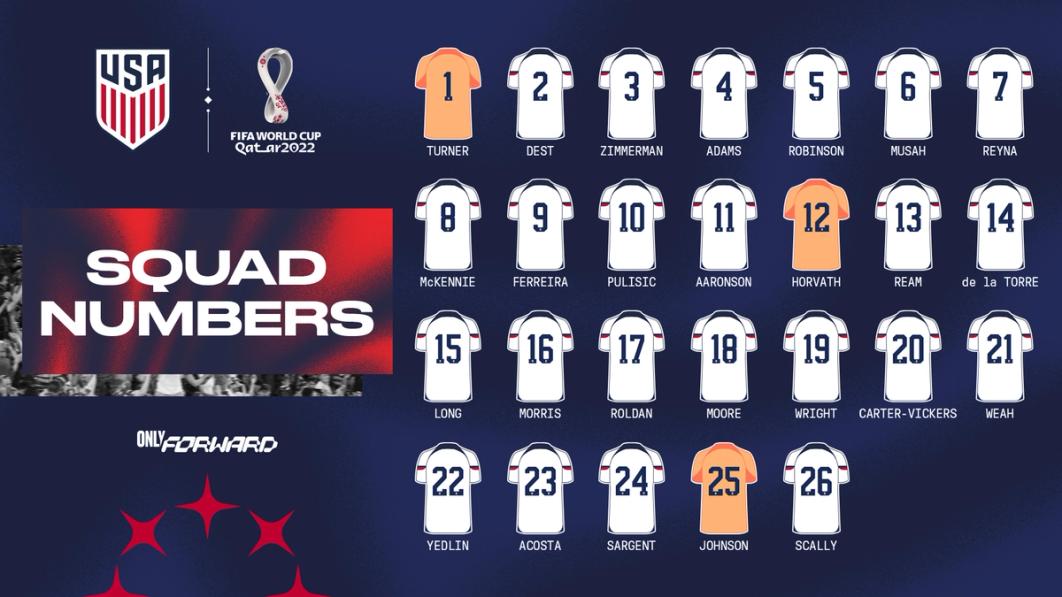



I will admit, as a long-time observer of the U.S. Men’s National Team, the way player jersey numbers are selected from camp to camp has always fascinated me. A mix of player seniority, what each player wears for their club and some other lesser-known intangibles determine which digits a player will end up with from game-to-game.
But the number a player wears at a FIFA World Cup is generally the one people remember the most. With the World Cup roster officially submitted to FIFA, here are the numbers for the 2022 squad and a detailed history of who previously wore each number for the USMNT at every modern era World Cup, the key performances therein and some of the other quirky stats that stick out.
The USA’s first No. 1 of the modern era, 21-year-old Tony Meola became the youngest goalkeeper to appear for the USMNT at a World Cup during Italia ’90. It’s a record that still stands today and is unlikely to be broken.
Meola’s captaincy of the team during four matches at USA ’94 made him the only goalkeeper to wear the armband at a World Cup, and with the historic 2-1 win against Colombia he became the first U.S. netminder to win a World Cup match in 44 years.
After wearing the No. 18 at USA ’94, Brad Friedel took the No. 1 shirt at France ’98 where he played in the group finale against Yugoslavia. More memorably, he was the starting goalkeeper during the USA’s scintillating run to the quarterfinals of Korea/Japan 2002.
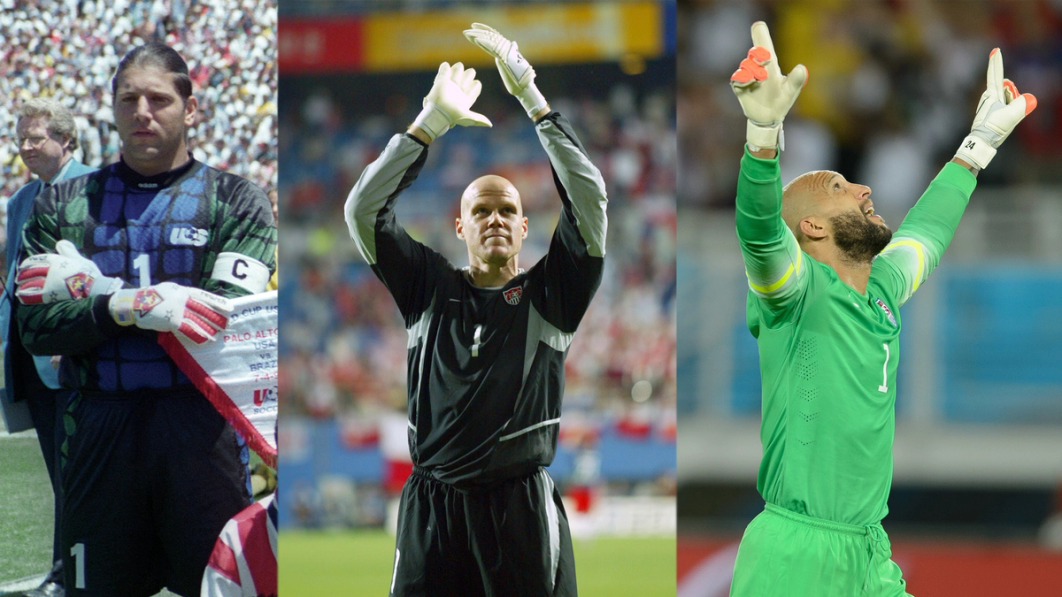
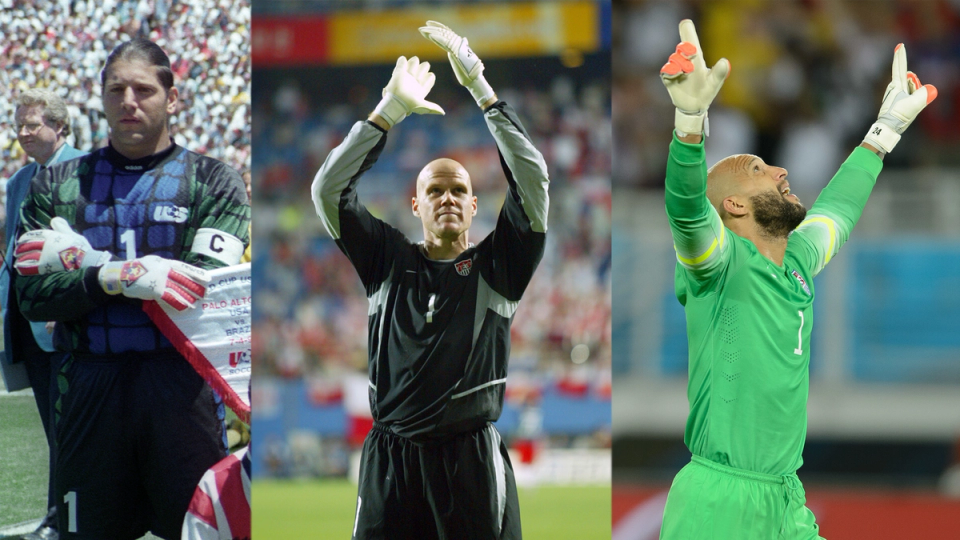
The Bay Village, Ohio product was crucial throughout the five matches in Korea and set a new tournament milestone when he saved two penalties during the group stage – one to help the USA to a 1-1 draw with hosts Korea Republic and another to keep things close in the 3-1 defeat to Poland in the group finale. Friedel also earned the USA’s first World Cup clean sheet in 52 years, making five saves to preserve the 2-0 win against Mexico in the Knockout Round.
One of seven players to wear the same number at three World Cups, Tim Howard sat in reserve of veteran Kasey Keller at Germany ’06, but manned the U.S. net for each of the next eight matches at South Africa 2010 and Brazil 2014, making him the goalkeeper with the most appearances in the No. 1 shirt for the USA at a World Cup. With wins against Algeria in 2010 and Ghana in 2014, Howard joined Friedel and 1930 backstop Jimmy Douglas as the only U.S. goalkeepers to win two matches at a World Cup. He also memorably became the USA’s “Minister of Defense” for his tournament-record 15-save performance against Belgium in the Round of 16 in Brazil.
8️⃣ years ago today @USMNT’s Tim Howard delivered a masterclass against Belgium in the 2014 FIFA World Cup Round of 16 coming up with a record-breaking 16 saves 🤯🇺🇸
— FOX Soccer (@FOXSoccer) July 1, 2022
(Via @USMNT) pic.twitter.com/CnDJcjGTb7
Should Matt Turner (Park Ridge, N.J.) start in Qatar, he would become the fourth New Jersey-born goalkeeper to man the nets for the USA at a FIFA World Cup, following Douglas (East Newark, N.J.), Meola (Belleville, N.J.) and Howard (North Brunswick, N.J.).
1990: Tony Meola - 3 GP / 270 MINS / 0 SO
1994: Tony Meola - 4 GP / 360 MINS / 0 SO
1998: Brad Friedel - 1 GP / 90 MINS / 0 SO
2002: Brad Friedel - 5 GP / 450 MINS / 2 SO
2006: Tim Howard – DNP
2010: Tim Howard - 4 GP / 390 MINS / 1 SO
2014: Tim Howard - 4 GP / 390 MINS / 0 SO
USMNT #2 – SERGIÑO DEST
The USMNT’s first modern era No. 2 was defender Steve Trittschuh, whose only World Cup appearance came in the 5-1 destruction at the hands of Czechoslovakia in the 1990 opener. Despite the defeat, Trittschuh’s play in that match and before the World Cup led to his signing by Czech side Sparta Prague, where he became the first U.S. international to appear in the UEFA European Cup – the precursor to the Champions League – later that fall.
Midfielder/defender Frankie Hejduk has given the most significant contributions as the USA’s World Cup No. 2. One of the bright spots at the 1998 tournament, “Dukes” created at least one dangerous chance in each group stage match in France: nearly equalizing seven minutes into the second half in the opener against Germany, having his 79th minute header well saved in the second match against Iran and seeing his looping cross beat Yugoslavia goalkeeper Ivica Kralj, only to have it come back off the left post. His play in France opened big doors, as he signed with Bundesliga side Bayer Leverkusen weeks after the USMNT exited the tournament.
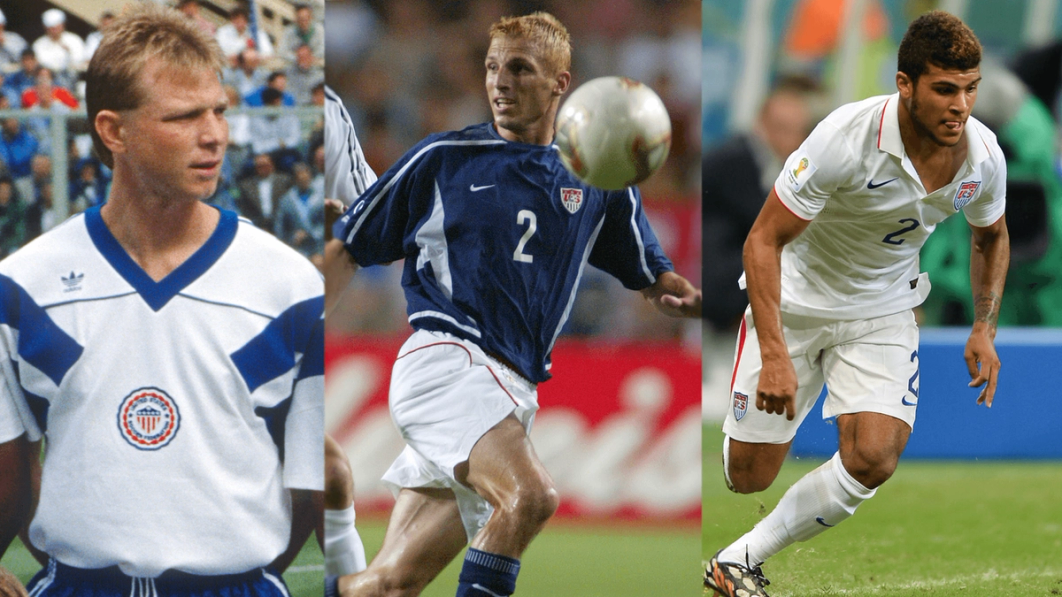
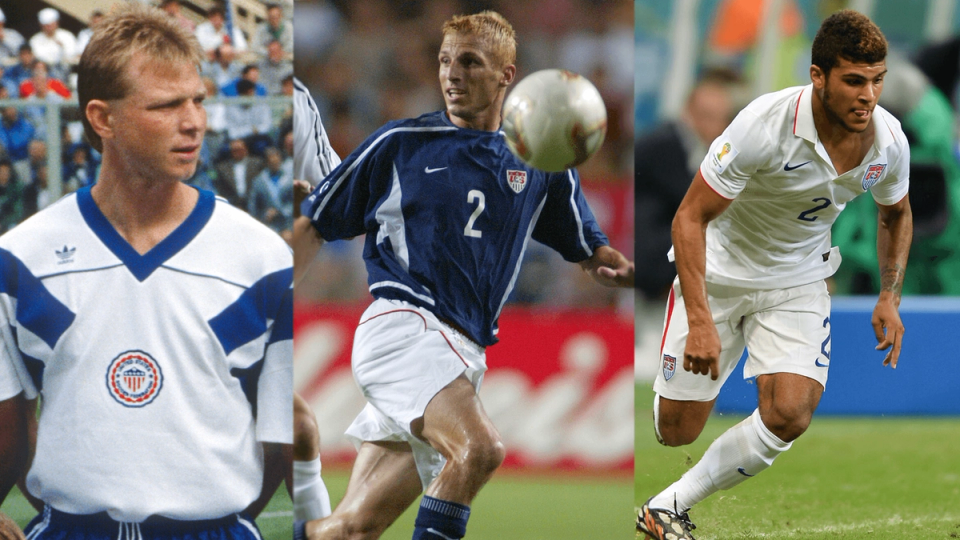
Despite only appearing in the USA’s first two qualifiers of the 2002 cycle, Hejduk came into strong form at the start of the year, helping Bruce Arena’s side win the Concacaf Gold Cup that February to earn a spot in the squad. Normally a right back, Hejduk won the starting left back job in the days leading up to the USA’s opening match in Korea and put in a yeoman’s performance throughout the group stage. Suspended from the USA’s Round of 16 match against Mexico, Hejduk returned to play as a left wing back in the 1-0 quarterfinal defeat to Germany. His seven World Cup appearances are the most by a USMNT No. 2.
Named to a third-straight roster for the 2006 FIFA World Cup, Hejduk broke his foot in his final league match before heading to World Cup camp and was replaced by Chris Albright on the roster for Germany. Despite his injury, Frankie still went to the World Cup as a fan, while Albright went unused in the USA’s three matches.
After Jonathan Spector also didn’t appear for the USA at South Africa 2010, budding winger/defender DeAndre Yedlin picked up the torch for USA No. 2’s four years later in Brazil. Today, he’s the only player on the 2022 roster with previous World Cup experience, but in 2014 he was the second-youngest player on the squad, having only made his debut that February. The Seattle product did enough to earn a place, making three substitute appearances during the tournament, including the 2-2 draw with Portugal.
1990: Steve Trittschuh – 1 GP / 90 MINS
1994: Mike Lapper - DNP
1998: Frankie Hejduk – 3 GP / 199 MINS
2002: Frankie Hejduk – 4 GP / 335 MINS
2006: Chris Albright – DNP / Frankie Hejduk (injured after final roster announcement)
2010: Jonathan Spector - DNP
2014: DeAndre Yedlin – 3 GP / 112 MINS
Made to watch from the bench as Czechoslovakia laid down a 5-1 drubbing in the Italia ’90 opener, center back John Doyle was thrust into the Starting XI for the next two group games, helping shore up the back line in narrow defeats to Italy (1-0) and Austria (2-1). Though he wore No. 23 with D.C. United, heralded center back Eddie Pope donned the No. 3 shirt early in his international career doing so in the first two group matches at France ’98.
Current USMNT head coach Gregg Berhalter was an unused sub through the group stage in Korea/Japan 2002, but when injuries and suspensions forced a formation change he was thrust into the Starting XI for the Round of 16 match against Mexico, helping the USMNT to the “Dos a Cero” win and its biggest victory in World Cup history.
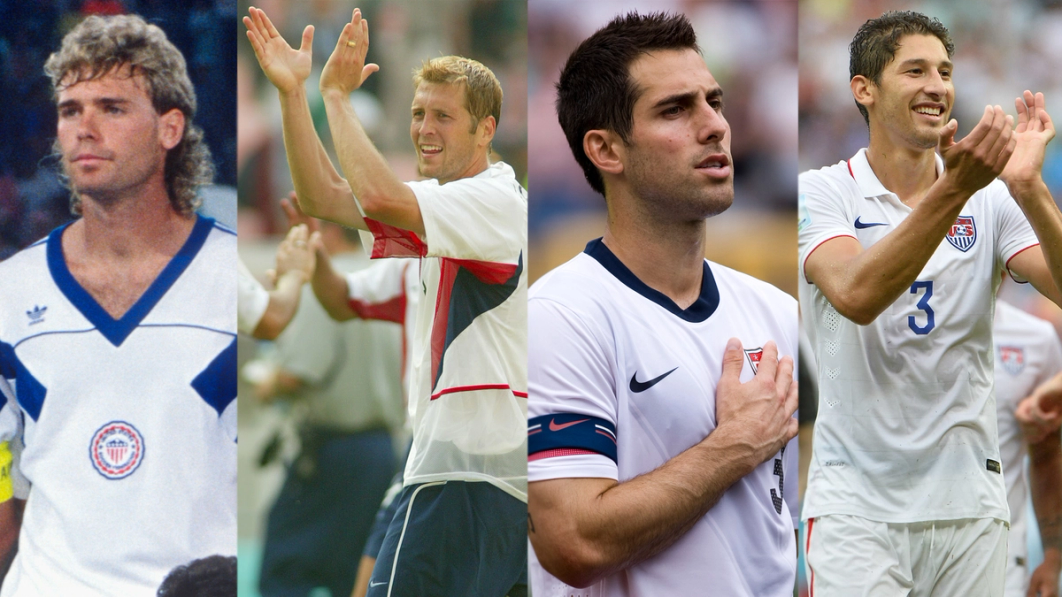
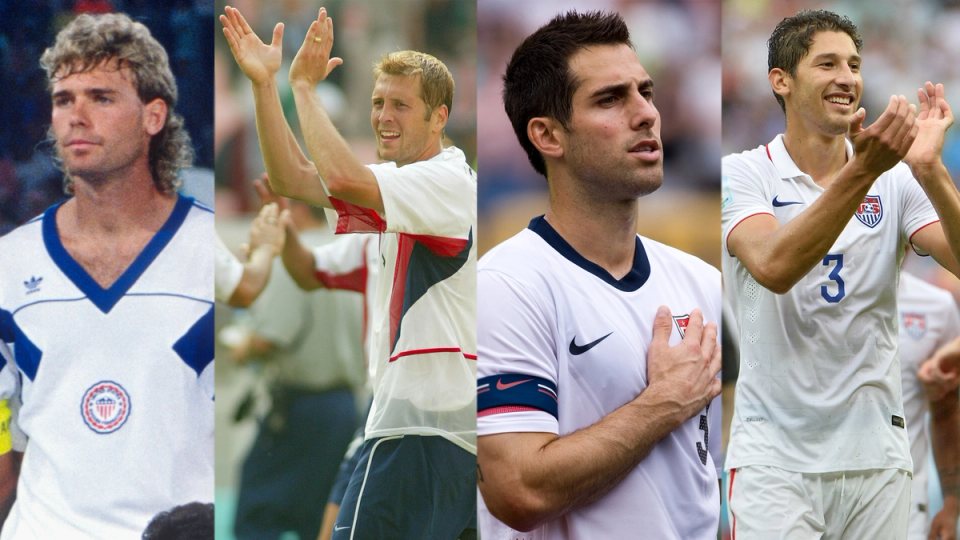
Berhalter again started in a back three for the quarterfinal against Germany and was robbed of a clear equalizing goal when his volley was handled by defender Torsten Frings on the goal line. In an age without VAR or goal-line technology, the USA’s vigorous protests for a penalty did nothing to change the mind of referee Hugh Dallas and the team eventually fell 1-0 to the tournament’s runner-up.
Versatile defender Carlos Bocanegra was inserted as the team’s left back in the second and third matches in Germany 2006, helping clean things up at the back in a 1-1 draw against eventual champions Italy and the 2-1 defeat to Ghana. Bocanegra, whose 64 matches as captain are the most of any USMNT player, wore the armband for the team’s four matches at South Africa 2010. The Alto Loma, Calif. product again plugged in at left back for the first two matches before pairing with Jay DeMerit in central defense for the 1-0 win against Algeria in the group finale and the 2-1 extra time defeat to Ghana in the Round of 16. Bocanegra’s six matches are the most by a USMNT No. 3 at the World Cup.
Omar Gonzalez was the USA’s most recent World Cup No. 3, starting two of his three appearances at Brazil 2014.
1990: John Doyle – 2 GP / 180 MINS
1994: Mike Burns - DNP
1998: Eddie Pope – 2 GP / 180 MINS
2002: Gregg Berhalter – 2 GP / 180 MINS
2006: Carlos Bocanegra – 2 GP / 180 MINS
2010: Carlos Bocanegra – 4 GP / 390 MINS
2014: Omar Gonzalez – 3 GP / 211 MINS
Another player thrust into the USA XI following the opening match thumping by Czechoslovakia at Italia ’90, defender Jimmy Banks started the final two group games, helping the USA keep things close in a 1-0 defeat to Italy and 2-1 loss to Austria. With those two appearances, Banks became the second Black player born in the United States to appear for the USMNT in a FIFA World Cup after teammate and close friend Desmond Armstrong became the first in the tournament opener days earlier.
Cle Kooiman, who was the first Mexican-based player to make a USMNT World Cup squad, played the opening match against Switzerland at USA ’94, before Mike Burns made two appearances at right back in France ’98.
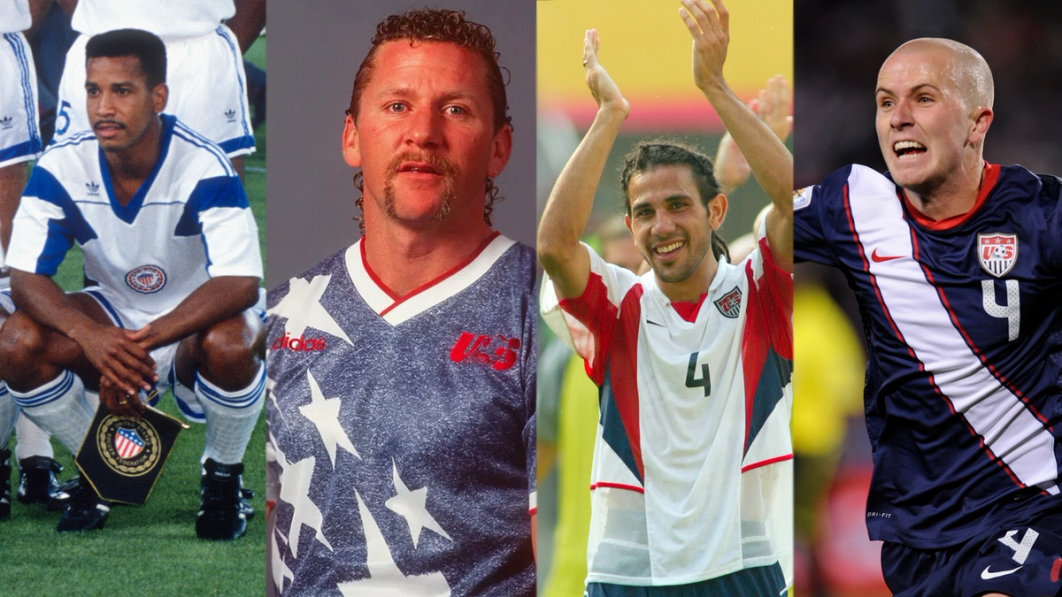
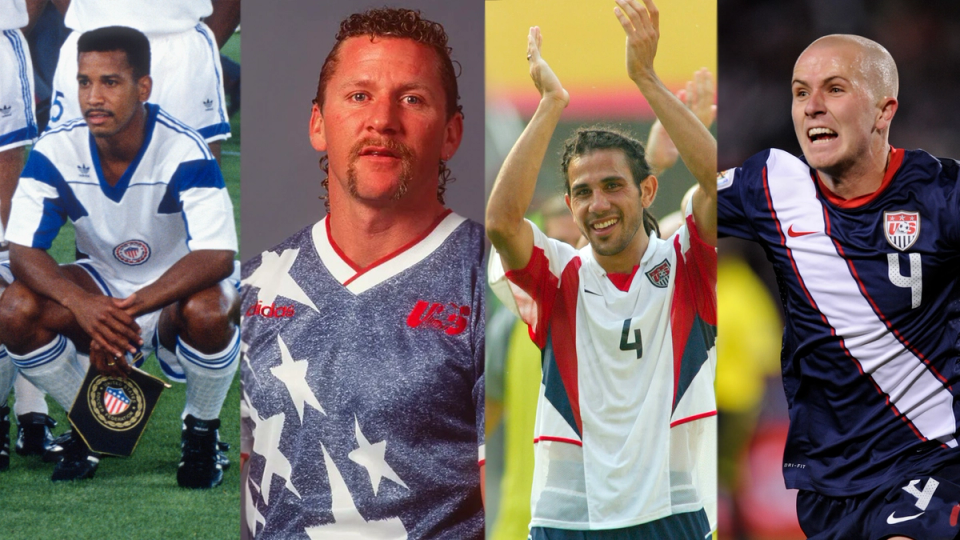
Two players made their mark with the No. 4 at the next four editions of the tournament. Argentina-born midfielder/defender Pablo Mastroeni, who had only one cap at the start of 2002, admirably slotted into the midfield for injured captain Claudio Reyna in the 3-2 win against Portugal at Korea/Japan 2002. He then turned in strong performances in both Knockout Round matches – the 2-0 win against Mexico in the Round of 16 and 1-0 quarterfinal defeat to Germany. Mastroeni wore the No. 4 again in 2006, but was limited to just two matches, forced to serve a suspension in the group finale after receiving a red card just before halftime in the 1-1 draw against Italy.
Michael Bradley took over the No. 4 shirt heading into the 2010 FIFA World Cup. The midfield general was one of seven players to play every minute in South Africa and most memorably scored the 82nd minute equalizer in the 2-2 draw with Slovenia in the second match. Bradley again appeared in all 390 minutes of action four years later in Brazil, registering a highlight-reel assist on Julian Green’s extra time goal in the 2-1 defeat to Belgium in the Round of 16. His eight appearances are the most by a USA No. 4 at the World Cup.
1990: Jimmy Banks – 2 GP / 135 MINS
1994: Cle Kooiman – 1 GP / 90 MINS
1998: Mike Burns – 2 GP / 135 MINS
2002: Pablo Mastroeni – 3 GP / 262 MINS
2006: Pablo Mastroeni – 2 GP / 90 MINS
2010: Michael Bradley – 4 GP / 390 MINS / 1 GOAL
2014: Michael Bradley – 4 GP / 390 MINS / 1 ASSIST
Mike Windischmann, who captained the USA through most of the qualification process, wore the armband for each of the USA’s three group stage matches at Italia ’90. Windischmann, who was born in Nuremberg, passed off the No. 5 to fellow German-born defender/midfielder Thomas Dooley, who wore it at both the 1994 and 1998 World Cups. Dooley also captained the USA at the latter tournament, with the 37-year-old becoming the second-oldest USMNT player to play in the World Cup after Fernando Clavijo. Dooley’s seven appearances are the most by a USA No. 5 at the World Cup.
John O’Brien took over the No. 5 for the next two tournaments, putting in a star performance at Korea/Japan 2002. It was his fourth-minute rebound that opened the scoring for the USA against Portugal in the tournament opener, with the goal standing as the earliest in USMNT World Cup history until Clint Dempsey’s strike 29 seconds into the 2014 match against Ghana.


O’Brien also provided an assist in the next match against South Korea, sending a beautiful chip into space for Clint Mathis, who coolly finished to open and the scoring and silence the home crowd. With that helper, O’Brien became the second of five USMNT players to register a goal and assist in the same World Cup tournament and he would join Brad Friedel and Tony Sanneh as the only three players to play every minute in 2002. Plagued by injuries in the leadup to the 2006 edition, his lone contributions were 45 minutes in the second half against Czech Republic – which was also the last competitive action of his career.
A pair of defenders took back the No. 5 after 2006, with Oguchi Onyewu wearing it in the first two matches of the 2010 FIFA World Cup. Matt Besler wore it at Brazil 2014, where he was the only center back to start all four U.S. matches.
1990: Mike Windischmann – 3 GP / 270 MINS
1994: Thomas Dooley – 4 GP / 360 MINS
1998: Thomas Dooley – 3 GP / 254 MINS
2002: John O’Brien – 5 GP / 450 MINS / 1 Goal, 1 Assist
2006: John O’Brien – 1 GP / 45 MINS
2010: Oguchi Onyewu – 2 GP / 170 MINS
2014: Matt Besler – 4 GP / 345 MINS
The No. 6 shirt was synonymous with John Harkes throughout his tenure with the U.S. Men’s National Team. In fact, while some of the match reports from early in his international career do not have numbers associated with players, U.S. Soccer currently has no record of him in another number for the senior team. Harkes was the No. 6 at both the 1990 and 1994 FIFA World Cups, playing a total of six matches – three at each tournament.
Harkes had a hand in each of the team’s first two goals in 1994. With the USA trailing 1-0 in the opening match against Switzerland, Harkes went on a penetrating run through the midfield before being fouled about 25 yards from goal, leading to Eric Wynalda’s equalizing free kick in the 1-1 draw.
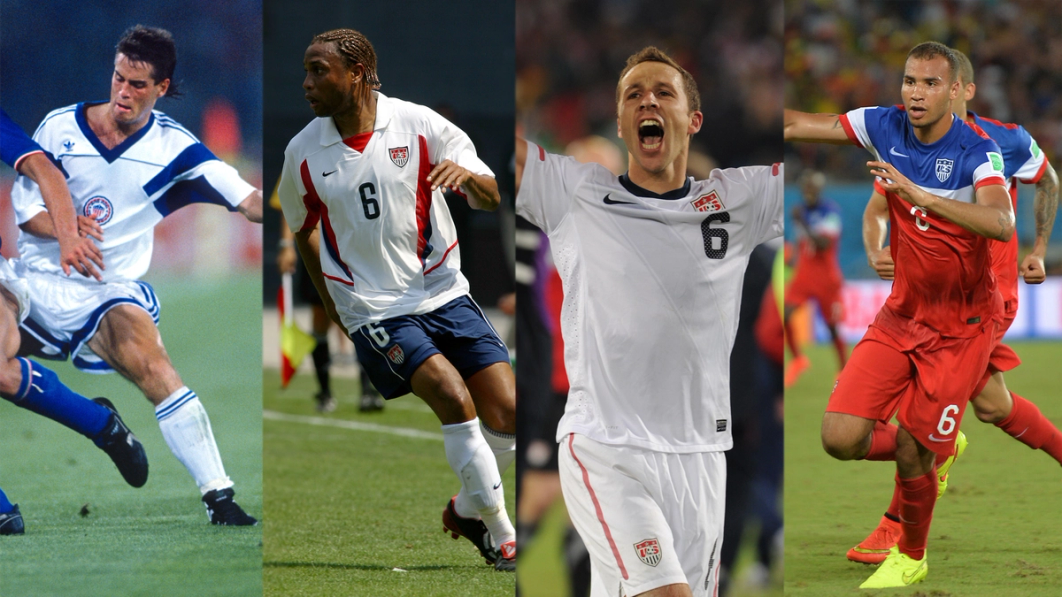
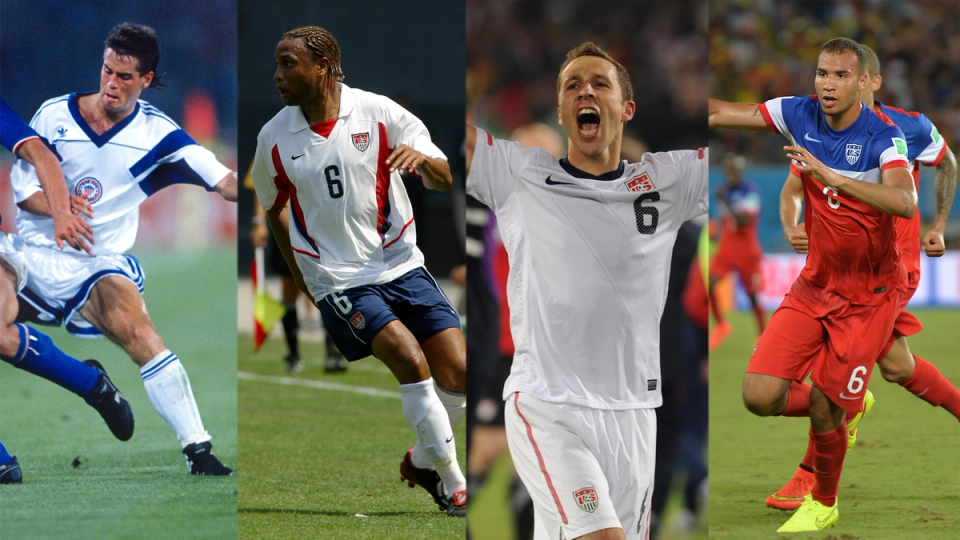
The midfielder’s biggest World Cup contribution came four days later against Colombia when his cross from the left deflected off Cafeteros’ defender Andrés Escobar and into the empty net, opening the scoring in what would become the team’s first World Cup victory in 44 years. The memory turned bittersweet 11 days later when Escobar was murdered outside a night club in Colombia. Harkes’ World Cup would end earlier than desired after being shown his second yellow card of the tournament in the group finale against Romania, forcing him to miss the Round of 16 clash with eventual champions Brazil.
Left back David Regis took over the No. 6 for 1998 and 2002. The French-born defender debuted just three days after gaining his citizenship, coming in a 0-0 draw with Kuwait in a World Cup sendoff friendly. Despite a lack of familiarity with his teammates, Regis had a decent tournament in France, most memorably hitting the post and providing a dangerous cross for Frankie Hejduk in the 2-1 defeat to Iran. He played all three group stage matches in 1998, but did not feature for the team in Korea four years later.
The 6 shirt rode on with Steve Cherundolo in Germany and South Africa. The experienced right back appeared in all seven matches across those two tournaments, making him the most utilized U.S. World Cup No. 6. The long-time Hannover 96 defender registered an assist during the 2010 edition, his long-ball setting up Landon Donovan’s goal against Slovenia early in the second half, kickstarting the USA’s comeback from a 2-0 halftime deficit.
John Brooks took over the No. 6 in Brazil, and while he only played 45 minutes the towering center back provided one of the most memorable moments in USMNT World Cup history. With the USA locked 1-1 with Ghana at halftime of the opener, the 21-year-old was called upon by Jurgen Klinsmann to replace the injured Matt Besler. Forty minutes after entering, Brooks powerfully headed home Graham Zusi’s corner from the right, giving the USA a dramatic 2-1 victory and avenging two previous World Cup defeats to the Black Stars. Brooks became the first substitute to score for the men’s team at the World Cup and also just the second defender, following Joe Maca’s goal against Chile in 1950.
1990: John Harkes – 3 GP / 270 MINS
1994: John Harkes – 3 GP / 270 MINS
1998: David Regis – 3 GP / 270 MINS
2002: David Regis – DNP
2006: Steve Cherundolo – 3 GP / 196 MINS
2010: Steve Cherundolo – 4 GP / 390 MINS / 1 ASSIST
2014: John Brooks – 1 GP / 45 MINS / 1 GOAL
Tab Ramos wore the No. 7 at Italia ’90 and was one of six to play all 270 minutes at the USA’s first World Cup in 40 years. Ramos also tallied an assist in Italy, showing some of his best attacking flair when he set up Bruce Murray’s 83rd minute goal to pull one back in the 2-1 defeat to Austria.
After injury forced him to miss out on the 1990 edition, Hugo Perez carried on the No. 7 shirt when he was named to the roster for USA ’94. One of two players on Bora Milutinovic’s roster to have participated in qualifying for the 1986 World Cup, Perez’s one and only tournament appearance came 10 years after his USMNT debut, replacing the suspended John Harkes for the USA’s Round of 16 defeat to Brazil on July 4.
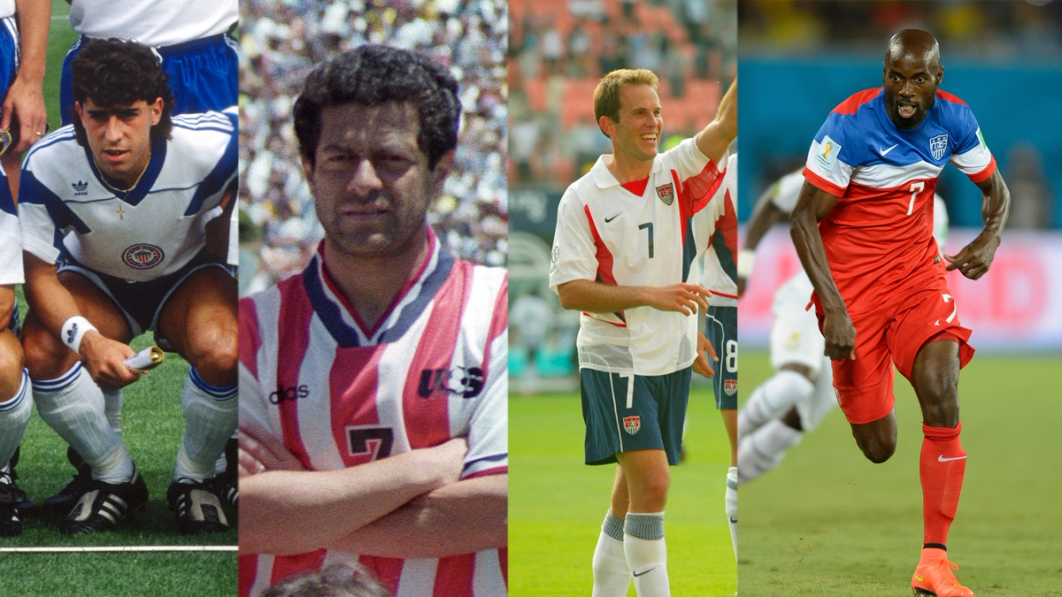
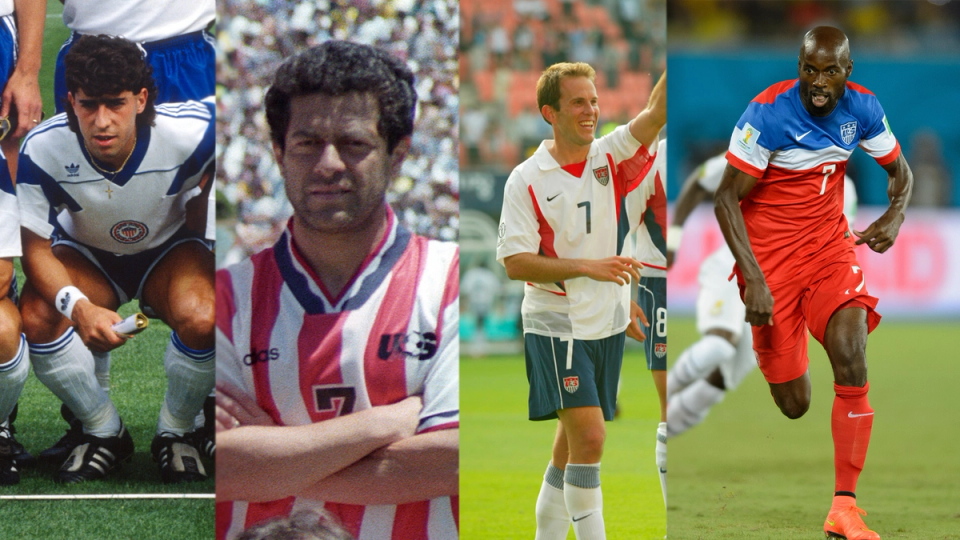
After wearing the No. 10 at the 1994 World Cup, veteran attacker Roy Wegerle took on the No. 7 shirt from his return to the team late in 1997 all the way through France ’98 where the veteran attacker playing his final two international matches against Germany and Iran.
Post-France, two players took ownership of the 7 shirt for the next four FIFA World Cups: Eddie Lewis and DaMarcus Beasley. In 2002, Lewis played just 15 minutes during the group stage, coming off the bench in the 1-1 draw with hosts Korea Republic, but a switch in formation saw him start and go the full 90 in both Knockout Round matches. His shining moment came in the Round of 16 win against Mexico, putting a pinpoint cross on the head of Landon Donovan to give the USA its most famous “Dos a Cero” victory against El Trí. Lewis saw action in two more matches at Germany ’06, starting at left back in the opener against the Czech Republic before moving back to the left wing in the group finale against Ghana.
Beasley – who wore No. 17 at the 2002 and 2006 World Cups – got the 7 shirt beginning in South Africa, but the veteran winger made only a cameo 80th minute appearance in the 1-0 win against Algeria. Having won the left back spot during qualifying, Beasley made history in the No. 7 shirt four years later in Brazil. When he started the tournament opener against Ghana, Beasley became the only U.S. male to play in four different FIFA World Cups. The veteran would was one of only four players to feature in all 390 minutes for the USA during the tournament.
1990: Tab Ramos – 3 GP / 270 MINS / 1 ASSIST
1994: Hugo Perez – 1 GP / 66 MINS
1998: Roy Wegerle – 2 GP / 84 MINS
2002: Eddie Lewis – 3 GP / 195 MINS / 1 ASSIST
2006: Eddie Lewis – 2 GP / 164 MINS
2010: DaMarcus Beasley – 1 GP / 10 MINS
2014: DaMarcus Beasley – 4 GP / 390 MINS
After Brian Bliss wore it for his substitute appearance against Austria in 1990, the No. 8 shirt became synonymous with two U.S. players for the next six FIFA World Cups – Earnie Stewart and Clint Dempsey.
Interesting enough, available U.S. Soccer records indicate the first time Stewart wore 8 for the National Team came in the opening match of the 1994 FIFA World Cup against Switzerland. The Federation’s current Sporting Director scored one of the biggest goals in USMNT history the following match, chipping home what stood as the game-winning goal in the 2-1 victory against Colombia – the USA’s first World Cup win in 44 years.
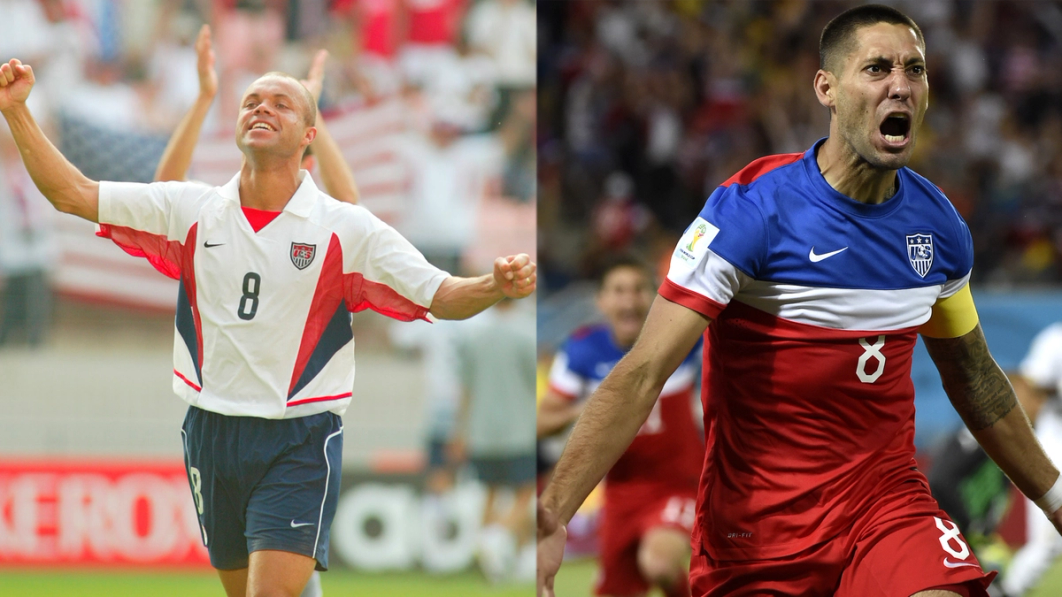
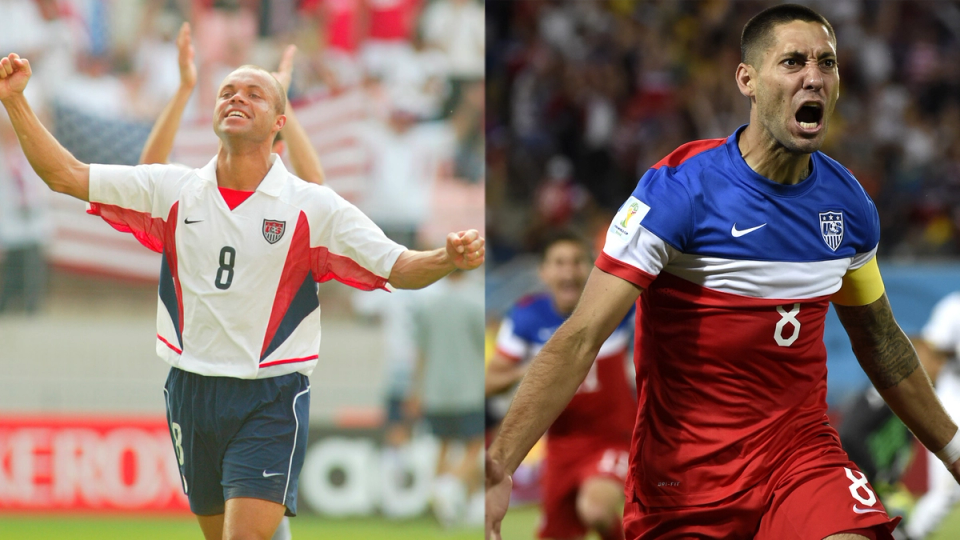
Appearing in all four matches at USA ’94, the tournament also began a run of eight-straight World Cup matches started by Stewart, stretching through the group stage at France ’98 to the opening game of the 2002 FIFA World Cup against Portugal. With regular U.S. captain Claudio Reyna injured heading into that match, Stewart wore the armband, becoming the first Black player to captain the USA at a FIFA World Cup and it was his fourth-minute corner kick that led to John O’Brien’s opening goal in the 3-2 upset win. After missing the next game against Korea Republic, Stewart played in the final three matches of the tournament, jointly setting what was a then-record 11 appearances by a U.S. male at the FIFA World Cup.
Dempsey became the USA’s No. 8 in 2006, bagging the only goal scored by a U.S. player in Germany when he got on the end of DaMarcus Beasley’s cross to level things in the group finale against Ghana. In 2010, Deuce joined former Fulham teammate Brian McBride as the second USMNT player to score in two different World Cups, when his shot from distance was bobbled by Robert Green, leading to the equalizer in the 1-1 draw with England during the opening match in South Africa.
In 2014, Dempsey scored the fastest U.S. goal at a World Cup, slicing through the Ghanaian defense before slotting home just 29 seconds into the 2-1 win against the Black Stars. Along with the fastest goal distinction, he became the only American man to score at three different editions of the tournament. In the next match, Dempsey nudged home with his abdomen what looked like a game-winner in the 2-2 draw against Portugal, making him the second USA player after Landon Donovan to score in back-to-back World Cup matches.
The five combined goals between Dempsey and Stewart make the 8 shirt the USA’s most successful scoring-wise at the modern era FIFA World Cup. The 1,911 minutes played between the USMNT’s three modern era No. 8s are the most of any field player number at the World Cup.
1990: Brian Bliss – 1 GP / 20 MINS
1994: Earnie Stewart – 4 GP / 325 MINS / 1 GOAL
1998: Earnie Stewart – 3 GP / 213 MINS
2002: Earnie Stewart – 4 GP / 154 MINS
2006: Clint Dempsey – 2 GP / 152 MINS / 1 GOAL
2010: Clint Dempsey – 4 GP / 390 MINS / 1 GOAL
2014: Clint Dempsey – 4 GP / 387 MINS / 2 GOALS
After Christopher Sullivan made two cameo appearances off the bench in Italy, his 1990 teammate Tab Ramos donned the 9 shirt for USA ’94. One of only six holdovers from Italia ’90, Ramos showed his incredible vision when he threaded a perfect ball through two Colombian defenders for Earnie Stewart who slotted his effort past ‘keeper Óscar Córdoba, to give the USA a 2-0 lead.
With Colombia pulling one back late, Ramos was credited with the USA’s first game-winning assist in modern era World Cup history. On the strength of his helper from Bruce Murray’s goal in 1990, Ramos is also the only U.S. man to record assists at two FIFA World Cups. While the New Jersey product would play in all four matches at USA ’94, a violent elbow from Brazil midfielder Leonardo forced him out of the Round of 16 match just before halftime and left him in the hospital for weeks after the tournament.


Joe-Max Moore was the USA’s No. 9 at the next two editions, starting against Iran and Yugoslavia at France ’98, before substitute appearances against Portugal and Poland in Korea/Japan 2002. Moore’s cameo against Poland was also his 100th and final international appearance. Similarly, Eddie Johnson came off the bench twice for the USA in 2006 and saw two close chances go begging in the opener against Czech Republic.
Despite having only two caps prior to May 2010, Herculez Gomez made the roster for South Africa on good club form after winning the Golden Boot during the recently-concluded Liga MX Clausura tournament. After making his World Cup debut as a late-game sub against Slovenia, Gomez started the group finale against Algeria and looked he provided a first-half assist to Clint Dempsey before the goal was deemed offside. Gomez again came off the bench to begin the extra time period in the Round of 16 match against Ghana.
Aron Johannsson was the latest World Cup No. 9, making his lone appearance as an injury replacement for Jozy Altidore in the opening match of the 2014 FIFA World Cup against Ghana.
1990: Christopher Sullivan – 2 GP / 21 MINS
1994: Tab Ramos – 4 GP / 288 MINS / 1 ASSIST
1998: Joe-Max Moore – 2 GP / 148 MINS
2002: Joe-Max Moore – 2 GP / 47 MINS
2006: Eddie Johnson – 2 GP / 74 MINS
2010: Herculez Gomez – 3 GP / 84 MINS
2014: Aron Johannsson – 1 GP / 67 MINS
One of the few players on the squad playing in Europe at the time, Peter Vermes became the USA’s first modern era World Cup No. 10 at Italia ’90. Having just wrapped the Eredivisie campaign with Volendam, Vermes scored his first three international goals in the months leading up to the tournament and played every minute of the three matches. In the second match against Italy, his equalizing attempt off a rebound was cleared just in front of the goal line after squeezing by goalkeeper Walter Zenga. In the group finale, Vermes was able to draw a 33rd minute red card on Austria midfielder Peter Artner and was part of the USA’s goal build-up, playing the initial pass for Tab Ramos that led to Bruce Murray’s goal.
Coventry City forward Roy Wegerle returned from a January knee injury to play a substitute role in all four matches at the 1994 FIFA World Cup. Tab Ramos followed Wegerle as the USA’s No. 10 at France ’98, joining Marcelo Balboa and Eric Wynalda as the first U.S. men to play in three World Cups.
More Trivia: Ramos became the only USMNT player to appear in three different numbers at the tournament (No. 7 in 1990, No. 9 in 1994).
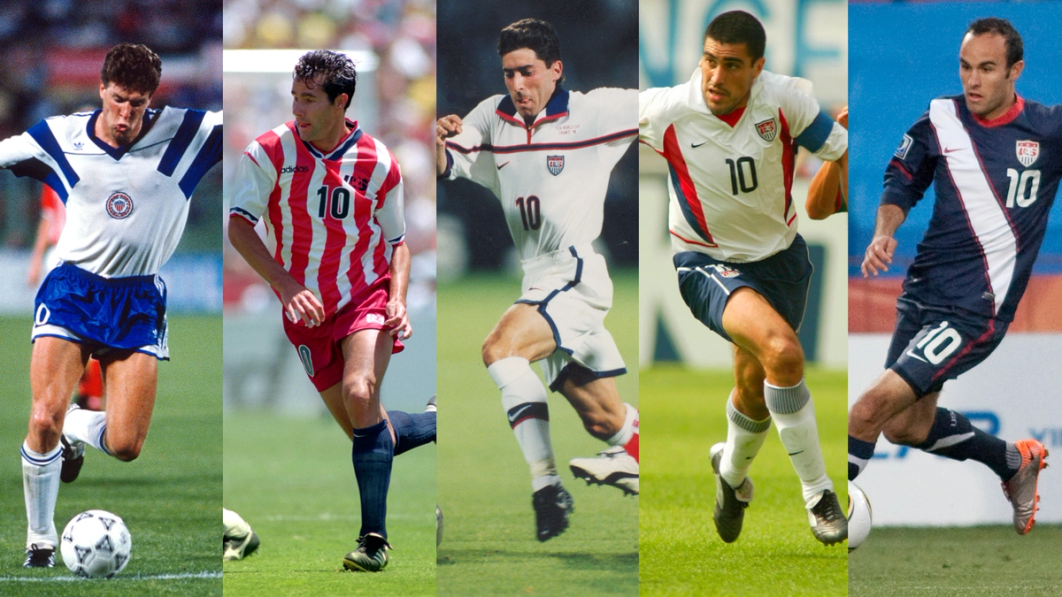

Claudio Reyna took over the No. 10 shirt and the main captaincy of the team at the beginning of the 2002 cycle, holding onto both through 2006.
Though he missed the 3-2 upset of Portugal in the 2002 opener, Reyna played every minute of the next four matches, leading to the team’s memorable quarterfinal run. The central midfielder showed his versatility in the Round of 16 clash with Mexico, with his ability to slot in at right wingback key in Bruce Arena’s decision to switch to a 3-5-2 formation. Reyna was instrumental in Brian McBride’s opening goal that day, when he also became the only USMNT player to captain the side in a World Cup Knockout Round win.
Four years later, Reyna joined Kasey Keller as the first USMNT players to make four World Cup rosters and became the only player to captain the USMNT in two World Cups, wearing the armband for all three matches in Germany. The day after suffering an injury which forced him out of the group finale against Ghana, Reyna was one of three players to announce their international retirement. Father to current USMNT attacker, Gio, Claudio is one of seven players to earn double-digit World Cup appearances, while the seven matches he captained are the most of any American man.
A teammate of Reyna’s in 2002 and 2006, Landon Donovan shined wearing the No. 10 in South Africa. His 47th minute goal against Slovenia sparked the team’s comeback from a 2-0 halftime deficit, but also made him the third American male to score at multiple World Cups.
He was responsible for perhaps the most memorable moment in USMNT lore in the following match, when his stoppage time winner against Algeria kept the USA from a group-stage exit, instead pushing the team to its first top of the group finish since 1930. In the Knockout Round against Ghana, Donovan became the only USMNT player to score in three-consecutive World Cup matches, and also the first to score from the penalty spot, with his 62nd minute equalizer pushing the match to extra time.
1990: Peter Vermes – 3 GP / 270 MINS
1994: Roy Wegerle – 4 GP / 103 MINS
1998: Tab Ramos – 2 GP/ 78 MINS
2002: Claudio Reyna – 4 GP / 360 MINS
2006: Claudio Reyna – 3 GP / 220 MINS
2010: Landon Donovan – 4 GP / 390 MINS / 3 GOALS
2014: Mix Diskerud - DNP
After making his USMNT debut that February, Eric Wynalda (pictured below) began a string of three consecutive FIFA World Cups as the team’s No. 11 at Italia ‘90. The San Diego State product turned 21 the day before the tournament opener, and showed his frustration with the team’s 3-0 deficit when he shoved Czecholslovakia’s Lubomir Moravcik from behind. Swiss referee Kurt Röthlisberger showed Wynalda a straight red card in the 52nd minute, forcing the USA down to 10 men and him out of the next match against Italy.
Wynalda returned in the group finale against Austria, but would make amends in the tournament opener on home soil four years later. After Switzerland’s Georges Bregy opened the scoring via a 39th minute free kick, Wynalda returned the favor to equalize just before halftime, rocketing a 25-yard free kick into the top left corner to energize the 73,000+ in attendance at the Pontiac Silverdome.
"To be honest, I was almost in disbelief," he said of the goal that gave the USA its first World Cup point in 44 years. "I did not know how to react after it went in...It was the greatest goal of my life."
Wynalda appeared in all four matches at World Cup ’94, and played twice more in France ’98, where his start in the tournament opener against Germany made him the first USMNT player to appear in three World Cups.
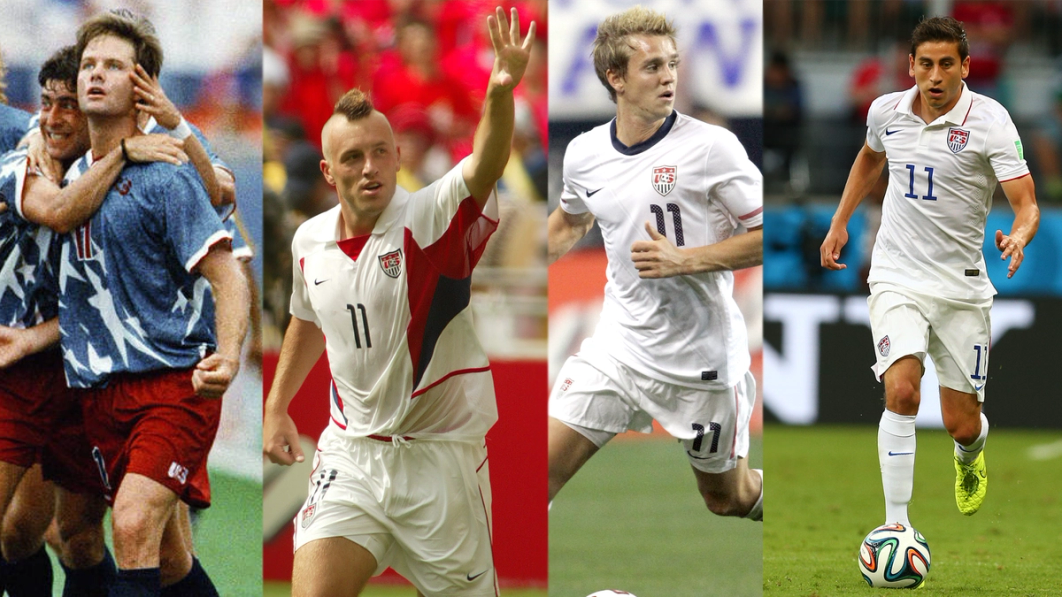
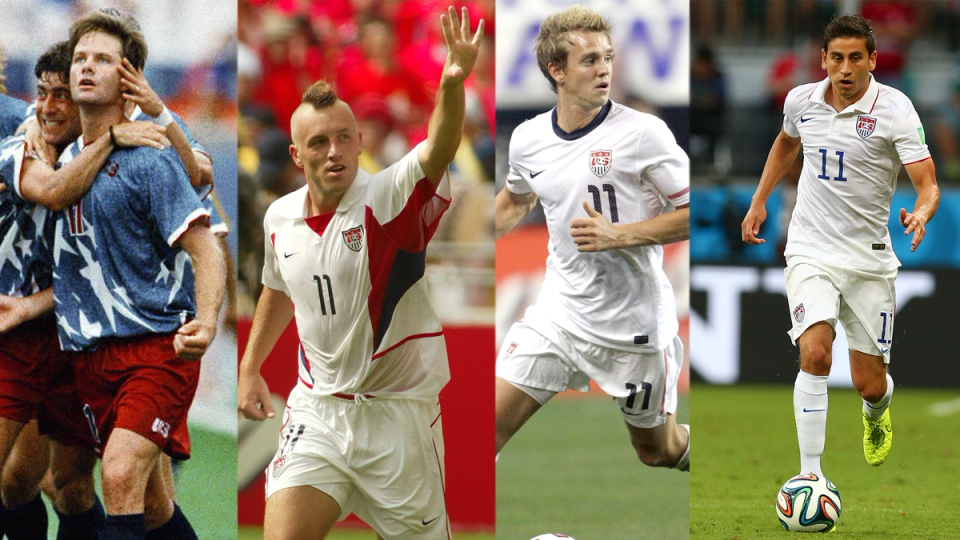
Clint Mathis took on the No. 11 in 2002, where he scored one of the most skilled goals in USMNT World Cup history in the 1-1 draw with Korea Republic. Displaying his newly minted Mohawk haircut for the match, Mathis received a lovely chipped ball from John O’Brien, taking it down with his right before finishing with his left to give the USA a 1-0 lead in the 25th minute and eventually an important 1-1 draw with the tournament hosts. With the USA trailing Poland 3-0 in the group finale, Mathis smacked a second-half effort off the left post, before nodding on to Landon Donovan who pulled one back for the USA in the 83rd minute. With that helper, Mathis followed O’Brien as the third USMNT player to record a goal and assist in the same tournament.
In 2010, Stuart Holden returned from a broken leg suffered in a friendly against Netherlands that March to make Bob Bradley’s roster, appearing as a late-game substitute in the opening 1-1 draw with England. Alejandro Bedoya, who just missed out on the roster for South Africa, appeared in all four U.S. matches in Brazil, logging 287 minutes as the team advanced from the Group of Death.
1990: Eric Wynalda – 2 GP / 125 MINS / 1 RED CARD
1994: Eric Wynalda – 4 GP / 252 MINS / 1 GOAL
1998: Eric Wynalda – 2 GP / 89 MINS
2002: Clint Mathis – 3 GP / 205 MINS / 1 GOAL / 1 ASSIST
2006: Brian Ching - DNP
2010: Stuart Holden – 1 GP / 4 MINS
2014: Alejandro Bedoya – 4 GP / 287 MINS
The No. 12 has the distinction of waiting the longest for its modern era World Cup debut. Reserves in each of the first three modern era World Cups, defender Paul Krumpe (1990), goalkeeper Juergen Sommer (1994) and defender Jeff Agoos (1998) didn’t see the field in any of their respective tournaments.
A 14-year veteran of the senior team, Agoos finally made his World Cup debut and became the first U.S. player to wear the 12 shirt at the tournament, playing all three group stage matches in Korea before an injury made him unavailable for the Knockout Round.


Defender Cory Gibbs was due to wear the 12 and expected to play a big role on the back line at Germany 2006, but suffered a torn ACL in the team’s first sendoff match against Morocco and was replaced on the roster Gregg Berhalter. After playing both Knockout Round games in 2002, the current USMNT head coach did not see any action in Germany.
Jonathan Bornstein, whose dramatic stoppage-time equalizer on the final day of qualifying lifted the USA to the top of the Concacaf Hexagonal, made two appearances as the No. 12 at World Cup 2010. After sitting on the bench through the first two games, Bornstein was summoned into his left back role when captain Carlos Bocanegra moved into central defense for the group finale against Algeria. Bornstein continued at left back, playing the entire 120 minutes in the 2-1 extra time defeat to Ghana in the Round of 16.
The backup to Tim Howard, reserve goalkeeper Brad Guzan was assigned the No. 12 for the USA in Brazil.
1990: Paul Krumpe - DNP
1994: Juergen Sommer - DNP
1998: Jeff Agoos - DNP
2002: Jeff Agoos – 3 GP / 216 MINS
2006: Gregg Berhalter - DNP / Cory Gibbs (injured after final roster was named)
2010: Jonathan Bornstein – 2 GP / 200 MINS
2014: Brad Guzan - DNP
After forward Eric Eichmann was an unused sub at Italia ’90, attacker Cobi Jones took over the No. 13 for the better part of the next decade, wearing it at the next three FIFA World Cups. With a June 16 birthday, Jones was always celebrating an anniversary of life around each tournament. He turned 24 two days prior to the opening match of the 1994 FIFA World Cup where he was mostly used as a super-sub by Bora Milutinovic, coming off the bench in each of the first three group stage matches before starting the Round of 16 contest against Brazil.
That role changed for the 28-year-old in France ’98, where the UCLA product was one of only three players to feature in every minute for the United States. Selected again for the 2002 roster, the veteran attacker moved back into a substitute role for Bruce Arena in Korea, where two of his four appearances came in helping the USA kill off matches in the 3-2 win against Portugal and 2-0 Round of 16 defeat of Mexico.
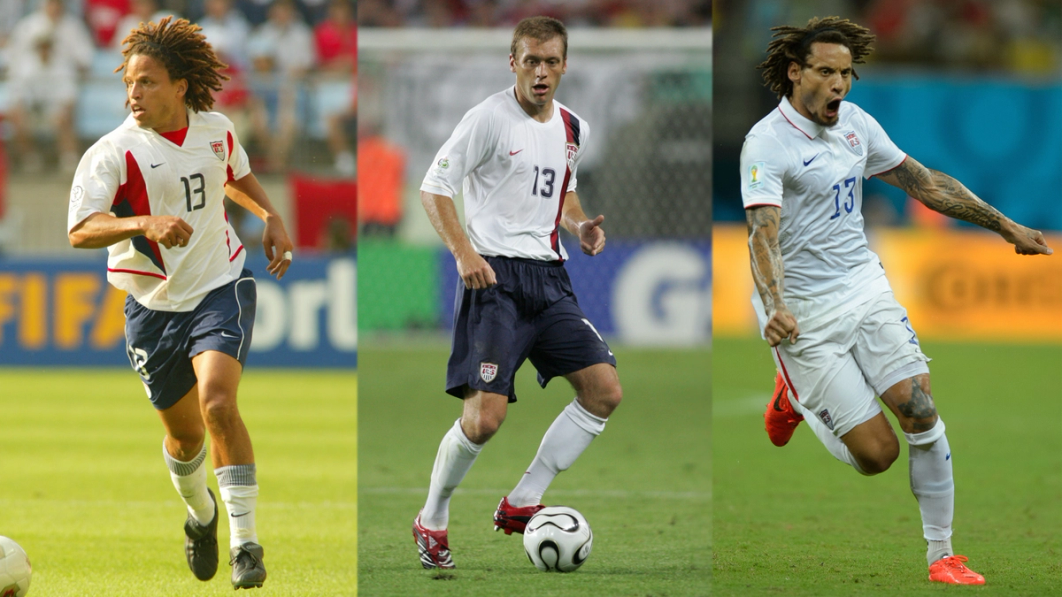
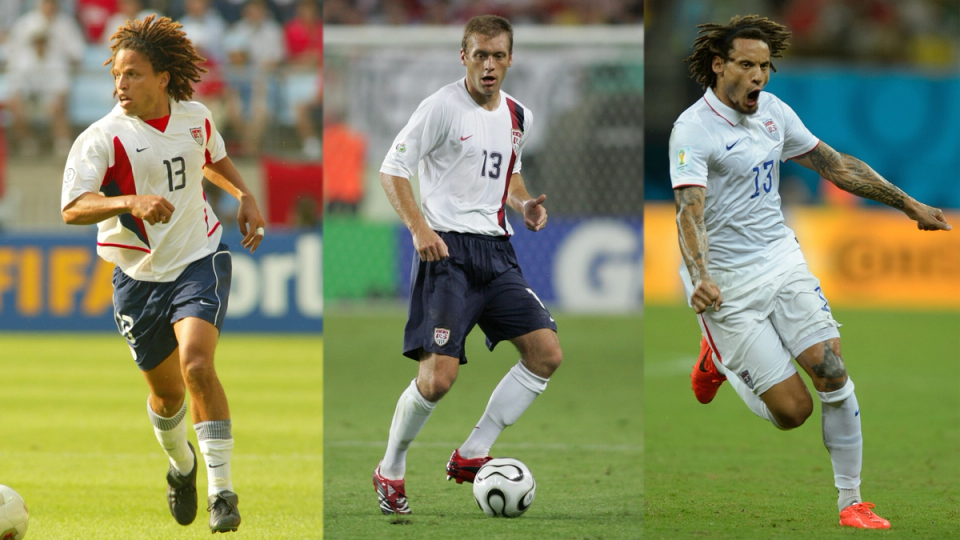
Though he only played the last 11 minutes against El Trí, Jones was particularly brutalized in the match and was the target of a headbutt from Rafa Marquez, drawing an 88th minute red card on the Mexico defender. Jones made his 11th and final World Cup appearance off the bench against Germany in the quarterfinal, tying him with Earnie Stewart and DaMarcus Beasley for second all-time among USMNT players.
Originally a reserve center back on Arena’s 2006 roster, Jimmy Conrad was thrust into action in the second match against Italy after Eddie Pope and Pablo Mastroeni were shown red cards. With the USA down to nine men, Conrad partnered with Oguchi Onyewu to shore up the defense and ensure a 1-1 draw against the eventual World Cup champions. Conrad then started the 2-1 defeat to Ghana in the group finale.
After Ricardo Clark wore the No. 13 in two matches at South Africa 2010, the number returned to a familiar name when Jermaine Jones took it on in 2014. The German-American midfielder had to wait until age 32 to make his World Cup debut, but he needed only 29 seconds to make an impact, playing provider on Clint Dempsey’s opening goal in the 2-1 win against Ghana.
Five years ago today. Jermaine Jones vs Portugal in the Amazon jungle. What. A. Goal. #usmnt @Jermainejunior pic.twitter.com/dwoeKlv2QG
— American Fútbol (@futbolmovie) June 22, 2019
Jones also wrote his name into World Cup lore in the following match, curling home a picture-perfect shot from distance to equalize for the USA in the 64th minute in the 2-2 draw against Portugal. Jones’ was only the fourth World Cup goal scored by the USMNT from outside the box and also made him the fifth U.S. player all-time to record a goal and assist in the same tournament.
1990: Eric Eichmann - DNP
1994: Cobi Jones – 4 GP / 152 MINS
1998: Cobi Jones – 3 GP / 270 MINS
2002: Cobi Jones – 4 GP / 103 MINS
2006: Jimmy Conrad – 2 GP / 128 MINS
2010: Ricardo Clark – 2 GP / 121 MINS
2014: Jermaine Jones – 4 GP / 390 MINS / 1 GOAL / 1 ASSIST
A fixture through most of qualifying, John Stollmeyer was the USA’s No. 14 at the 1990 World Cup, playing the first two matches against Czechoslovakia and Italy. Frank Klopas, another player who missed out on consideration for Italia ’90 through injury, made Bora Milutinovic’s squad fours later. Despite leading the team with six goals in the lead-up to the tournament, the striker saw now action at USA ’94.
In the 1998 FIFA World Cup, Preki Radosavljević took on the 14 shirt. The Serbian-born attacking midfielder first came to the USA to play indoor soccer in the 1980s, before spending two seasons with Everton in the early 1990s. By virtue of his time spent in the U.S, Preki acquired citizenship in the fall of 1996 and aided in the team’s qualifying campaign for France ’98. The 34-year-old made his World Cup debut off the bench against Iran and became the oldest USMNT player to record a World Cup assist when his corner kick found Brian McBride at the back post late in the 2-1 defeat.

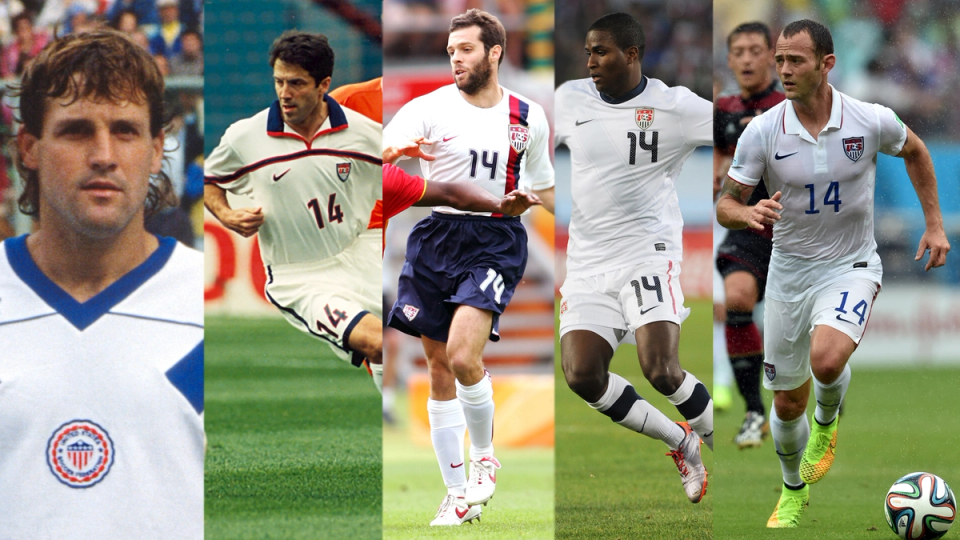
Locked in as the U.S. No. 14 throughout the 2002 cycle, Chris Armas was going to be heavily relied on by Bruce Arena in Korea. That all changed when the New York-born midfielder tore his ACL in the team’s first sendoff series match against Uruguay – a devastating blow to one of the key figures in the U.S. team at that time. Armas was replaced on the squad by Greg Vanney and the defender suffered a knee injury of his own in the next warmup match against Jamaica. Finally, 23-year-old defender Steve Cherundolo was named as Armas’ replacement, but even he didn’t get to don the No. 14 in Korea, as the right back suffered his own injury in training prior to the tournament.
After a brutal injury left him unable to take part in 2002, veteran midfielder Ben Olsen made his only World Cup appearance when he replaced Claudio Reyna in the 2006 group finale against Ghana. Riding a hot start to the MLS season, Edson Buddle was the USA’s 14 four years later in South Africa, making two substitute appearances against England and Algeria in the group stage. Renowned for his dead-ball delivery, midfielder Brad Davis made the trip to Brazil in 2014, starting the 1-0 defeat to Germany in what would also be his last international appearance.
1990: John Stollmeyer – 2 GP / 74 MINS
1994: Frank Klopas - DNP
1998: Preki – 2 GP / 65 MINS / 1 ASSIST
2002: Steve Cherundolo - DNP / Chris Armas (injured after final roster was named)
2006: Ben Olsen – 1 GP / 50 MINS
2010: Edson Buddle – 2 GP / 39 MINS
2014: Brad Davis – 1 GP / 59 MINS
There were plenty of historic moments around the USA’s involvement at Italia ’90. While it was the team’s first World Cup appearance in 40 years, defender Desmond Armstrong’s appearance in the opening match against Czechoslovakia marked the first time a Black, U.S.-born player featured for the United States at the tournament. The marking back was one of six U.S. players to play every minute in 1990 and went on to make 81 total appearances for the USMNT.
After Joe-Max Moore was an unused sub at USA ’94, defensive midfielder Chad Deering wore the No. 15 at France ’98, making his sole World Cup appearance in the opening 2-0 defeat to Germany.
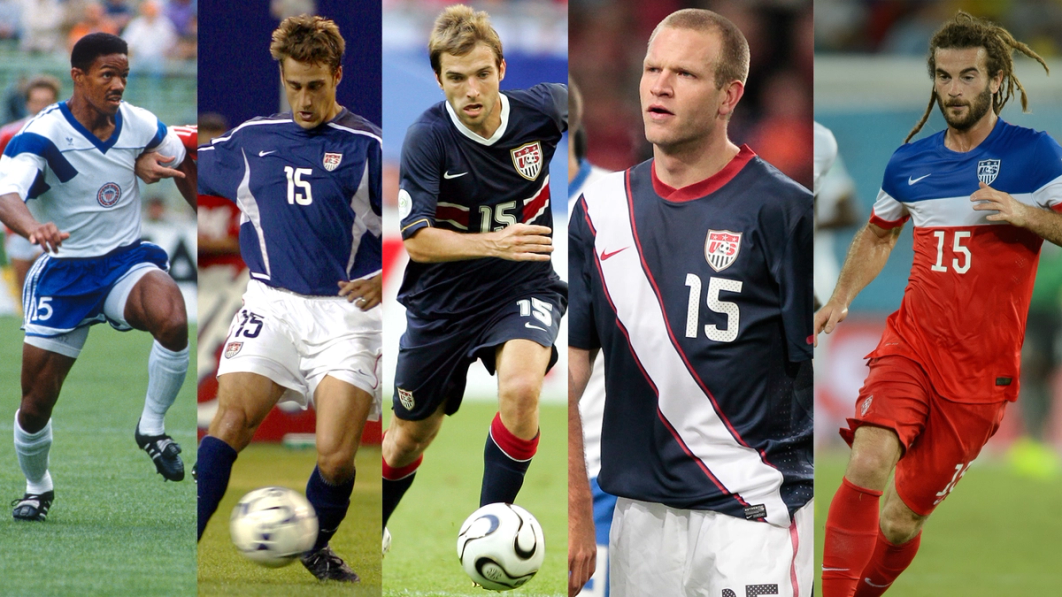

Josh Wolff may have only played 66 minutes in Korea four years later, but he made a mark with his limited time. After a short substitute appearance against the hosts during the group stage, Wolff – who had plenty of previous success against Mexico – started the Round of 16 match against El Trí and provided the crucial lay back pass for Brian McBride to open the scoring in the eighth minute. The USA would go on to win by the famous “Dos a Cero” score line, while Wolff’s helper makes him the only USMNT player with a game-winning assist in a World Cup Knockout Round.
Fresh off a fantastic promotion campaign with English Championship side Reading, Bobby Convey appeared in all three matches at Germany 2006, starting against the Czech Republic and Italy. Jay DeMerit was the USA’s No. 15 four years later. The inspirational figure, who gained prominence by rising through the ranks of English football and eventually scoring the goal that put Watford in the English Premier League, played all 390 minutes during the team’s memorable run in South Africa.
In 2014, Kyle Beckerman was rock solid in center midfield for Jürgen Klinsmann’s side, playing all 270 minutes of the group stage, helping the USA advance to the Round of 16 for a second-straight tournament.
1990: Desmond Armstrong – 3 GP / 270 MINS
1994: Joe-Max Moore - DNP
1998: Chad Deering – 1 GP / 69 MINS
2002: Josh Wolff – 2 GP / 66 MINS / 1 ASSIST
2006: Bobby Convey – 3 GP /158 MINS
2010: Jay DeMerit – 4 GP / 390 MINS
2014: Kyle Beckerman – 3 GP / 270 MINS
One of the USA’s first consistent attacking players, Bruce Murray was part of the team’s historic World Cup return in 1990. In Italy, the Maryland-born forward registered the USMNT’s first modern-era World Cup assist when he slotted Paul Caligiuri through to pull one back in the 5-1 defeat to Czechoslovakia. After a brave performance saw the young side fall 1-0 to hosts Italy in the second match, Murray made more history in the tournament finale against Austria. With the USA trailing 2-0 in the second half, Tab Ramos beat a defender in the box and centered for Murray, whose one-time effort was partially saved before trickling over the goal line. With the goal, Murray became the first USMNT player to score and provide an assist in the same FIFA World Cup.
Sometimes forgotten is the immense performance by No. 16 Mike Sorber at USA ’94. Having earned his first USMNT caps in 1992 while still playing at the University of Saint Louis, Sorber became an important, if not unheralded member of the team in the build-up to the World Cup. His role would become even more important when Claudio Reyna suffered a hamstring injury just before the start of the tournament. Partnering with Thomas Dooley in midfield, Sorber started all four matches, doing the dirty work while Dooley pushed the attack.
While he didn’t have much in the way of stats to his name, Sorber received high praise from Milutinovic in his post-tournament assessment, “When you analyze the World Cup, Sorber was probably our MVP. It is difficult for me to explain what I feel about him. He is disciplined and intelligent.”
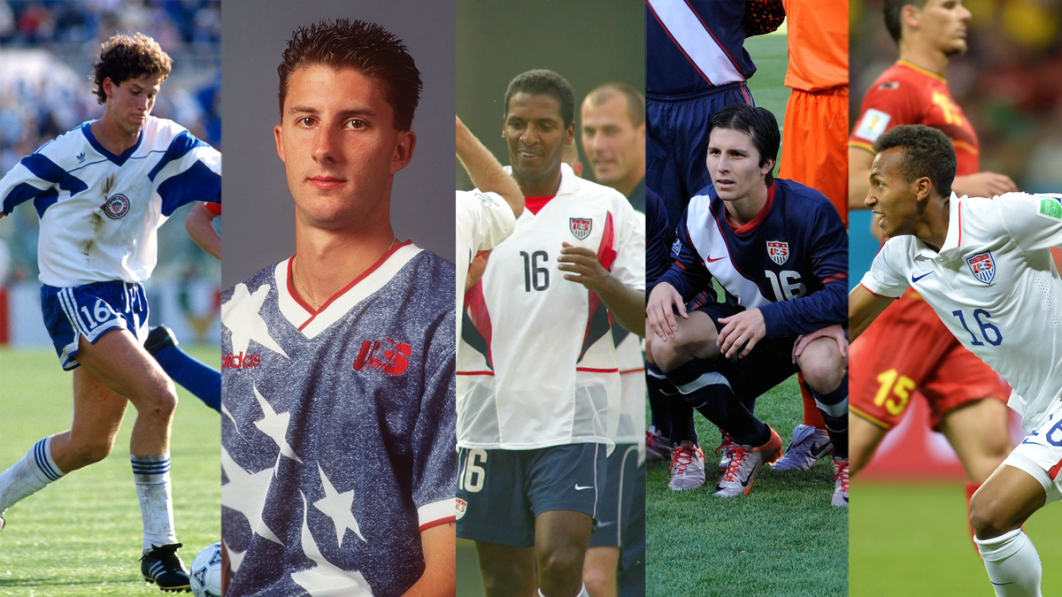
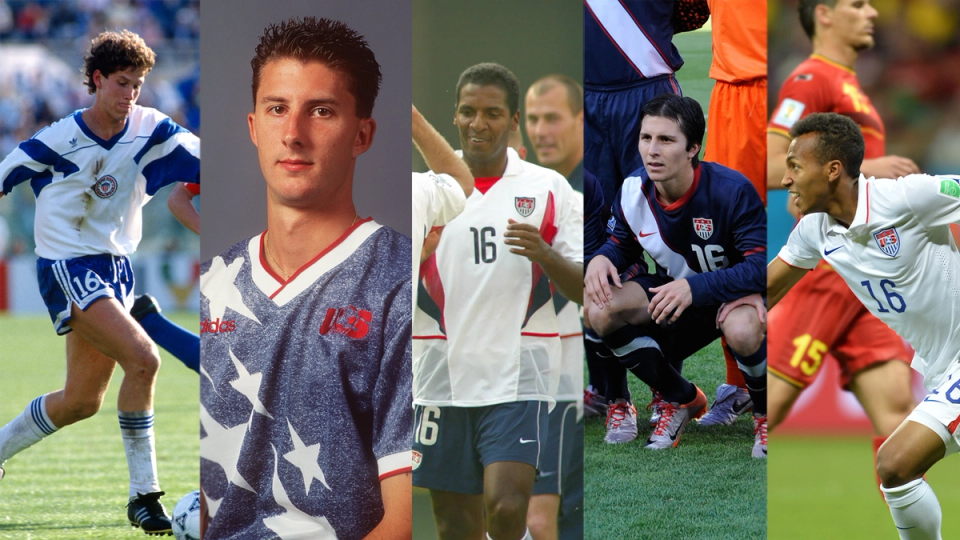
After reserve goalkeeper Juergen Sommer served as the No. 16 in 1998, veteran defender Carlos Llamosa continued with the shirt in 2002. Hailing from Colombia, Llamosa famously was working as a janitor at the World Trade Center when the building was first bombed in 1993. Three years later, he was playing for D.C. United in Major League Soccer and earned his U.S. citizenship in 1998. A reliable veteran presence for Bruce Arena, Llamosa made two appearances for the USA in Korea, coming on as a late substitute to close out the wins against Portugal and Mexico.
Josh Wolff played in his second World Cup in Germany 2006, coming off the bench in the 3-0 defeat to Czech Republic. Four years later, Jose Torres became just the second player based in Liga MX to play for the USA at the World Cup when he started the match against Slovenia.
Julian Green, who only made his USA debut less than two months before the squad was named, was the No. 16 for the 2014 World Cup in Brazil. Born in Tampa but raised in Germany, the 19-year-old Green was the second-youngest player named to a USMNT World Cup roster, coming in after only 17-year-old Joe Martinelli who was an unused substitute at the 1934 tournament in Italy. Green himself went unused through the group stage, but then wrote his name into U.S. World Cup history when he scored a breath-taking volley during extra time in the USA’s 2-1 Round of 16 defeat to Belgium. The 107th minute strike stands as the latest goal scored by the USMNT at the World Cup, while Green holds the record as the USA’s youngest scorer at the tournament.
1990: Bruce Murray – 3 GP / 249 MINS / 1 GOAL / 1 ASSIST
1994: Mike Sorber – 4 GP / 344 MINS
1998: Juergen Sommer - DNP
2002: Carlos Llamosa – 2 GP / 11 MINS
2006: Josh Wolff – 1 GP / 13 MINS
2010: José Torres – 1 GP / 45 MINS
2014: Julian Green - 1 GP / 1 GOAL / 15 MINS
If the USMNT had a No. 17 on the field in the 1990s, the odds were it was Marcelo Balboa. The first U.S. man or woman to record 100 caps, according to available U.S. Soccer records the venerable defender wore the 17 shirt in at least 112 times during his international career and did so at FIFA World Cups in 1990, 1994 and 1998.
Just 22 years old at his first World Cup, Balboa appeared in all three matches in Italy and was one of six holdovers that made Bora Milutinovic’s squad for the tournament on home soil four years later. In that edition, he again appeared in all four matches and came inches from scoring off a bicycle kick which would have taken the U.S. lead to 3-0. The veteran defender took on a reserve role in France ’98, playing just nine minutes at the end of the group finale against Yugoslavia which saw him join teammates Eric Wynalda and Tab Ramos as the first USMNT players to feature in three World Cups.
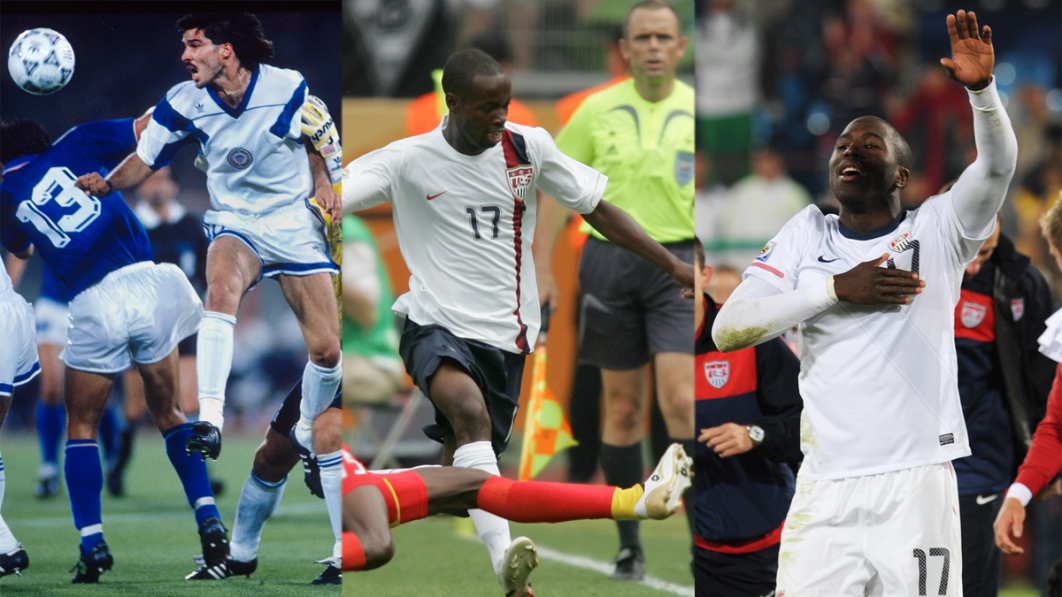

DaMarcus Beasley, who wore No. 7 with the Chicago Fire at the time and showed a preference for that number early in his National Team career, took on the No. 17 shirt for 2002 as the more veteran Eddie Lewis had first claim to the 7 shirt. With both players on the 2002 and 2006 squads, this was the precedent between the two at each tournament. Having turned 20 during the flight to Korea, Beasley was the youngest player on the squad and when he started the tournament opener against Portugal, became the youngest USMNT player to feature in a World Cup – a feat only surpassed by Julian Green in 2014.
Beasley performed admirably during the three group stage matches in 2002 and also featured in the same trio of matches four years later in Germany. During the group finale against Ghana, it was Beasley whose cross from the left picked out Clint Dempsey for the U.S. equalizer in the 2-1 defeat.
As Lewis moved out of the National Team, Beasley began to take on his preferred No. 7 more frequently during the 2010 cycle, opening the door for Jozy Altidore to lay claim to the 17 shirt.
Like Beasley in 2002, the 20-year-old striker was the youngest player on Bob Bradley’s squad in South Africa and provided danger for the U.S. in every match. With the score tied 1-1 in the opener against England, Altidore broke into the box on the left and fired an effort towards the near post that Robert Green deflected back off the bar. In the following match against Slovenia, nodded on a ball for Michael Bradley who put home the equalizer in the USA’s 2-2 comeback draw. With the USA desperate for a goal in the second half of the group finale against Algeria, Altidore had a header well saved by Algeria keeper Rais M’bohli. With time running out, it was his cross from the right that led to Landon Donovan’s famous game-winning goal.
Altidore returned for his second World Cup in 2014, but injured his hamstring 19 minutes into the opening match against Ghana, effectively ending his tournament.
1990: Marcelo Balboa – 3 GP / 206 MINS
1994: Marcelo Balboa – 4 GP / 360 MINS
1998: Marcelo Balboa – 1 GP /8 MINS
2002: DaMarcus Beasley – 3 GP / 219 MINS
2006: DaMarcus Beasley – 3 GP / 208 MINS / 1 ASSIST
2010: Jozy Altidore – 4 GP / 357 MINS / 1 ASSIST
2014: Jozy Altidore – 1 GP / 23 MINS
A traditional goalkeeper number, the 18 shirt has been worn by U.S. netminders in six of the seven modern era World Cups. Longtime backstop Kasey Keller owned the 18 through much of his international career, wearing it in at least 98 matches for the USMNT and is the only American player to lay claim to the same number at four editions of the tournament.
After serving as backup to Tony Meola in 1990 and being left off 1994 roster – when Brad Friedel was assigned the 18 shirt -- Keller staked his claim to the starting goalkeeper spot for France ’98 after strong performances in qualifying and a stellar display in the USA’s 1-0 upset of Brazil in the Concacaf Gold Cup semifinal that February. He started the first two matches a 2-0 defeat to Germany and 2-1 loss to Iran – and with the U.S. officially eliminated, sat in reserve of Friedel in the group finale against Yugoslavia.

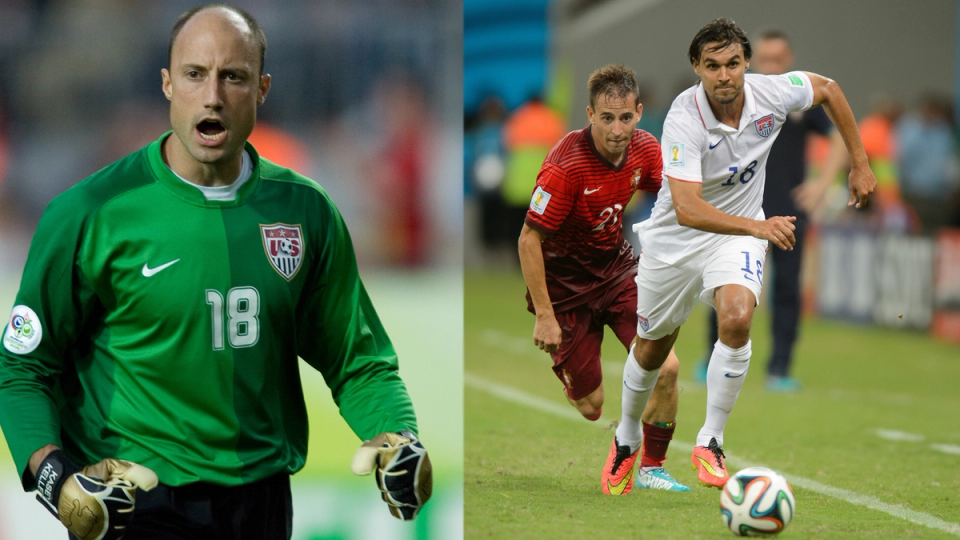
The starting goalkeeper battle between Keller and Friedel heated up a great deal during the 2002 cycle, with the two largely splitting the duties in half. Bruce Arena named his squad for the World Cup without knowing which goalkeeper he would eventually start, but after Keller picked up a slight injury during a warmup match against Jamaica, the nod went to Friedel. The memorable trip to Korea would be the veteran’s third World Cup, but second watching from the bench.
When Friedel retired from the National team in 2004, Keller became Arena’s clear first-choice and started all three matches for the USA at Germany 2006, doing so 16 years after his first World Cup trip in 1990. His inclusion alongside Claudio Reyna also made the duo the first two U.S. players to make four World Cup rosters.
With backup goalkeeper Brad Guzan assigned the 18 shirt in 2010, it finally shifted to a field player in 2014 with Chris Wondolowski making two appearances off the bench in Brazil
1990: Kasey Keller - DNP
1994: Brad Friedel - DNP
1998: Kasey Keller – 2 GP / 180 MINS
2002: Kasey Keller - DNP
2006: Kasey Keller – 3 GP / 270 MINS
2010: Brad Guzan – DNP
2014: Chris Wondolowski – 2 GP / 51 MINS
During the first two modern era World Cups, the No. 19 went to the youngest players on each roster – Chris Henderson, who was also age 19 in 1990, and Claudio Reyna, who was 20 at USA ’94. Henderson was an unused sub throughout the team’s time in Italy, while Reyna suffered a hamstring injury that kept him from seeing action in his first World Cup.
Midfielder Brian Maisonneuve, who had only a handful of caps prior to being named to the 1998 roster, appeared in all three matches in France. The 19 then shifted to the third-choice goalkeepers at each of the next two tournaments, Tony Meola getting it for his third World Cup trip in 2002 and Marcus Hahnemann for his first of two in 2006.


The USA’s most notable World Cup 19s were the last two – Maurice Edu in 2010 and Graham Zusi in 2014. Having scored his first international goal in a warmup friendly against Czech Republic, it was Edu who looked to have grabbed the game-winner in what would have been an incredible 3-2 comeback victory against Slovenia. Instead, U.S. fans will remember the phantom foul called in that sequence, a controversial play that is only rivaled in U.S. World Cup lore by the lack of a handball call on Torsten Frings during the 2002 quarterfinal against Germany.
In 2014, Zusi started three of his four appearances and made history as the lone USMNT player to record multiple assists at a FIFA World Cup. With the USA locked 1-1 with Ghana late in the opener, Zusi entered the match in the 77th minute and served up the corner kick which John Brooks headed home to give Jurgen Klinsmann’s side a dramatic 2-1 victory. Zusi started the match four days later against Portugal and helped put the USA ahead 2-1 when Clint Dempsey used his abdomen to put home his cross in the 81st minute of the eventual 2-2 draw.
1990: Chris Henderson - DNP
1994: Claudio Reyna - DNP
1998: Brian Maisonneuve – 3 GP / 188 MINS
2002: Tony Meola - DNP
2006: Marcus Hahnemann - DNP
2010: Maurice Edu – 3 GP / 198 MINS
2014: Graham Zusi – 4 GP / 260 MINS / 2 ASSISTS
Paul Caligiuri, who scored the goal to put the USMNT in Italia ’90, also scored the USA’s first World Cup goal in 40 years, providing the lone bright spot in the 5-1 defeat to Czechoslovakia. After appearing in all three matches in Italy, Caligiuri again wore the No. 20 at USA ’94, playing every minute of the four games for Bora Milutinovic.
Current USMNT general manager Brian McBride was the team’s No. 20 for the next three FIFA World Cups. McBride made his tournament debut against Iran in 1998, and nearly changed the course of the match when he nodded a first-half chance off the crossbar. With the USA trailing 2-0 late, he made his mark on the tournament, heading home Preki’s corner kick at the back post to pull a goal back in the 2-1 defeat.

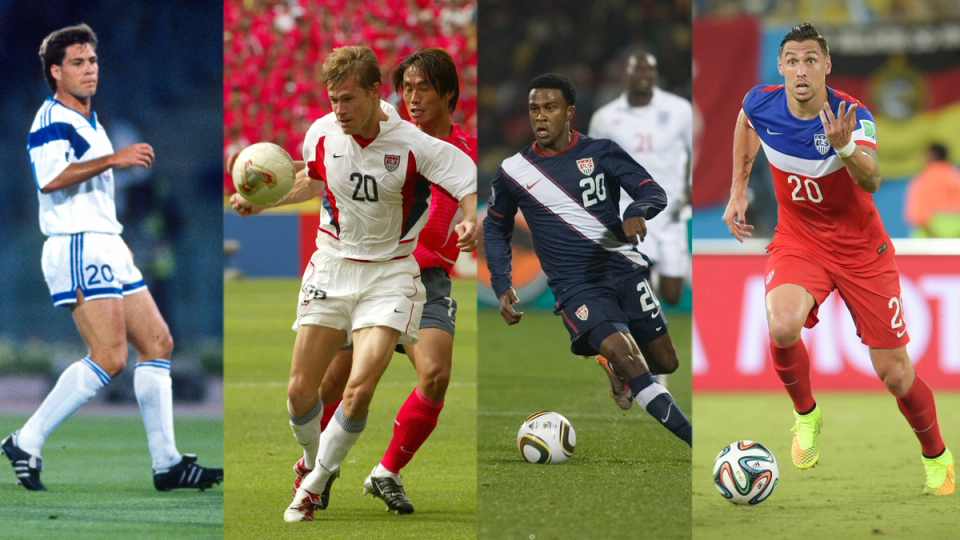
While there were a number of key performers at the 2002 World Cup, McBride’s contributions in Korea were central to the team’s quarterfinal run. Continuing to show his aerial prowess McBride put a stamp on things just four minutes into the opener against Portugal when his header on Earnie Stewart’s corner kick led to John O’Brien’s goal to put the U.S. ahead 1-0. After Landon Donovan forced an own goal to make it 2-0, McBride got his name on the score sheet when he dove to nod home Tony Sanneh’s cross to make it 3-0 in the 36th minute. With the goal, McBride became the first USMNT player to score in multiple World Cups, while the three-goal advantage matched the team’s biggest lead on any World Cup opponent since their matching 3-0 wins against Belgium and Paraguay in 1930.
McBride got things started early again in the Round of 16 clash against Mexico, with his quick restart finding Claudio Reyna streaking up the right flank before centering a ball for Josh Wolff on the end line. Wolff cleverly cut it back for McBride, finished the opening goal after just eight minutes. The goal made McBride the first USMNT player since Bert Patenaude in 1930 to score multiple goals in a World Cup and also pushed the USA onto its most famous “Dos a Cero” win against El Trí.
McBride returned as the grizzled veteran striker in 2006. He played all three group matches in Germany, but will probably best be remembered for the brutal elbow he received from Italy’s Daniele De Rossi in the second match. McBride’s face was left bloody and the Italian was shown a red card in the 28th minute. The USA’s man advantage was short lived after Pablo Mastroeni and Eddie Pope were sent off on both sides of halftime, setting the stage for a nine-man U.S. squad to earn a 1-1 draw with the soon-to-be World Cup champs.
With serious questions about which other forwards would join Jozy Altidore at the 2010 FIFA World Cup, Robbie Findley emerged and started three matches against England, Slovenia and Ghana. In 2014, Geoff Cameron played the first two matches at center back, before taking on a defensive midfield role in the Round of 16 loss to Belgium.
1990: Paul Caliguri – 3 GP / 250 MINS / 1 GOAL
1994: Paul Caligiuri – 4 GP / 360 MINS
1998: Brian McBride – 2 GP / 180 MINS / 1 GOAL
2002: Brian McBride – 5 GP / 375 MINS / 2 GOALS
2006: Brian McBride – 3 GP / 257 MINS
2010: Robbie Findley – 3 GP / 167 MINS
2014: Geoff Cameron – 3 GP / 300 MINS
The second-youngest player on the 1990 roster, 20-year-old Neil Covone did not play a part for the USA in Italy. In contrast, 37-year-old Fernando Clavijo became the oldest player to appear for the USMNT at a World Cup, playing in three matches at USA ’94. The Uruguay-born defender also became the second USMNT player sent off in a World Cup when he received a second yellow card in the 1-0 loss to Brazil in the Round of 16. The late defender announced his retirement from the game the following day, making it the last act of his incredible 22-year career.
Unable to play for the U.S. in 1994, four years later Claudio Reyna made his World Cup debut in the 21 shirt. The midfielder played all three matches and nearly opened the scoring against Iran when he fired a curling, left-footed effort off the right post.

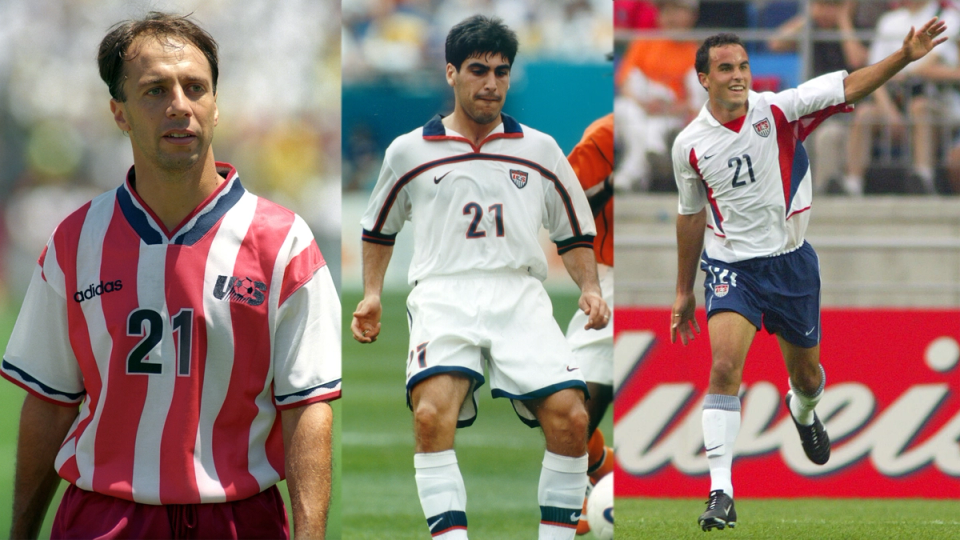
With Reyna shifting to the 10 shirt in 2002, Landon Donovan wore 21 during his first two FIFA World Cups in 2002 and 2006. The 20-year-old was dangerous from the opening whistle in Korea, his cross from the right leading to the USA’s second goal in the 3-2 upset of Portugal in the tournament opener, before he scored his first of five career World Cup goals in the 3-1 defeat to Poland in the group finale. In the Round of 16, the speedy attacker caught Mexico out in transition, getting on the end of an Eddie Lewis cross in the second half to affirm the famous “Dos a Cero” victory against El Trí. Donovan was the most dangerous player on the field for the U.S. in the quarterfinal, when he was twice thwarted by strong goalkeeping from Oliver Kahn in the 1-0 defeat to Germany.
Donovan – who appeared in all five matches for the USMNT in Korea – earned the tournament’s “Best Young Player” award. Four years later, he played every minute of every game, but has admitted that he had a disappointing World Cup in Germany.
The 21 shirt hasn’t seen action for the USMNT at the World Cup since then, with defenders Clarence Goodson and Timmy Chandler going as unused subs in 2010 and 2014, respectively.
1990: Neil Covone - DNP
1994: Fernando Clavijo – 3 GP / 266 MINS / 1 RED CARD
1998: Claudio Reyna – 3 GP / 270 MINS
2002: Landon Donovan – 5 GP / 435 MINS / 2 GOALS
2006: Landon Donovan – 3 GP / 270 MINS
2010: Clarence Goodson - DNP
2014: Timmy Chandler - DNP
After making a crucial penalty save late in a qualifier against Costa Rica the year before, veteran goalkeeper David Vanole went to Italia ’90 as the third goalkeeper and the USA’s No. 22. Four years later, Alexi Lalas, with his long red hair and distinct goatee, stuck out as much for his looks as his play. One of the top performers at USA ’94, he had the distinct honor of making his World Cup debut just miles away from his hometown of Birmingham, Michigan when the USA opened with a 1-1 draw against Switzerland at the Silverdome in Pontiac. Four days later, Lalas’ second-half header against Colombia nearly gave the USA its first three-goal lead in a World Cup since the 3-0 win vs. Paraguay at Uruguay 1930.
After appearing in all four matches during the USMNT’s historic showing, Lalas became the first U.S. international to play in the Italian Serie A, lining up for Padova the next two seasons before returning for the launch of Major League Soccer in 1996. The veteran center back earned another U.S. roster spot at France ’98, but did not appear during the tournament.
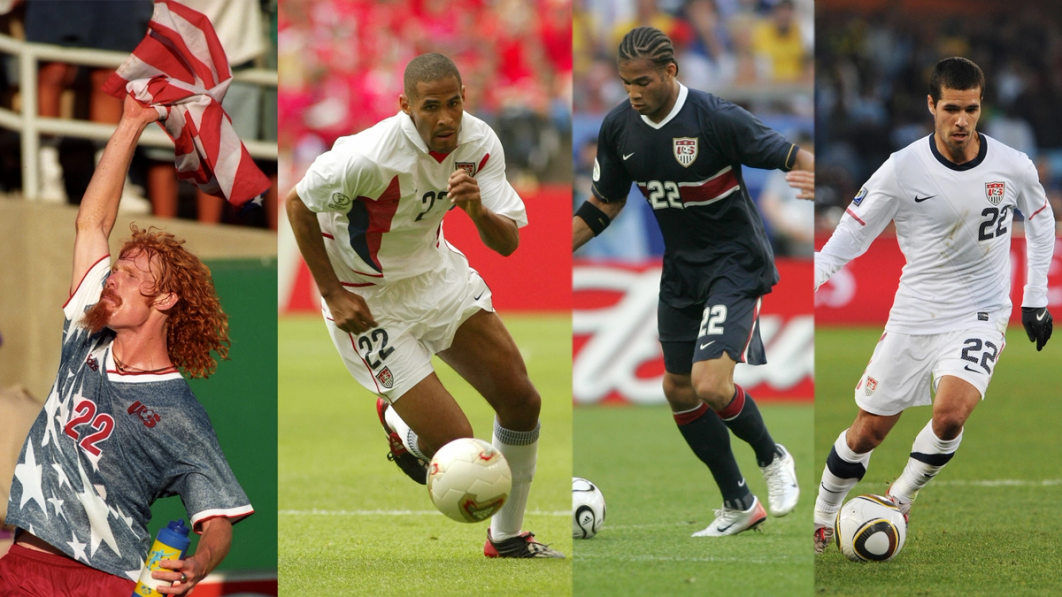
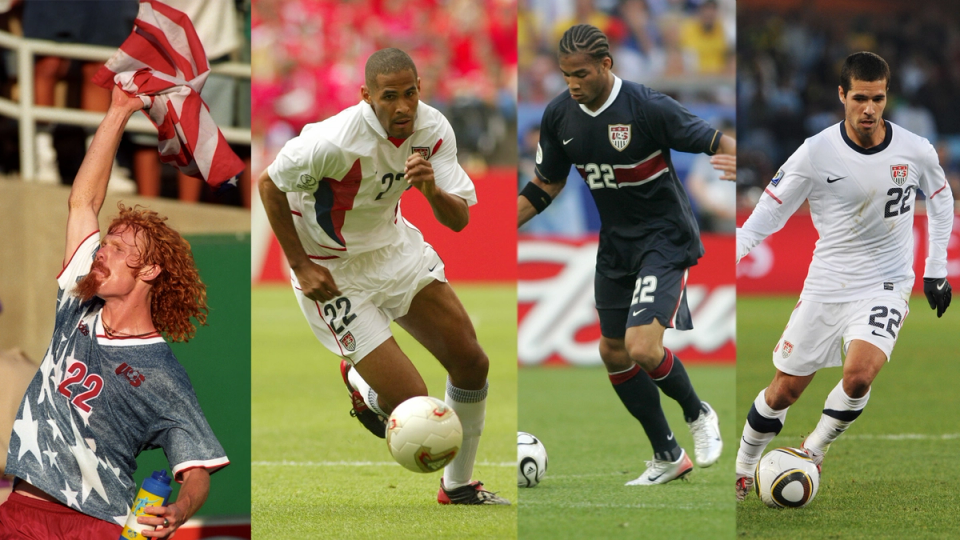
Just like Lalas in 1994, Tony Sanneh was one of the tournament revelations for the USA at the 2002 World Cup in Korea. A player that could line up in multiple positions, Sanneh won the right back job in the lead-up and proved his worth as one of only three U.S. players to appear in every minute of the competition. In the tournament opener, he served up what would stand as the game-winning assist to Brian McBride, whose diving header gave the USA a dream 3-0 lead 36 minutes into the match against Portugal. When the USA shifted its formation in the Knockout Round, Sanneh lined up as a right-sided center back, again playing admirably in both matches.
Making his first of two World Cup rosters in 2006, center back Oguchi Onyewu was one of three players to appear in every minute for Bruce Arena in Germany. With the USA going down two men by the 47th minute, the 24-year-old defender helped lock down the defense in the brave 1-1 draw against Italy in the second match. In an unfortunate turn of events, Onyewu was called for the penalty kick that led to Ghana’s game-winner in the 2-1 defeat to the Black Stars in the group finale.
Benny Feilhaber made three substitute appearances for Bob Bradley at South Africa 2010 and was the last No. 22 that saw action for the USA at the World Cup. After going unused in the tournament opener against England, Feilhaber became the only player in USMNT World Cup history to come off the bench at the start of the second half in three matches at the same tournament.
Like Vanole in 1990, veteran Nick Rimando served as the USA’s third-choice goalkeeper under Jurgen Klinsmann in Brazil.
1990: David Vanole - DNP
1994: Alexi Lalas – 4 GP / 360 MINS
1998: Alexi Lalas - DNP
2002: Tony Sanneh – 5 GP / 450 MINS / 1 ASSIST
2006: Oguchi Onyewu – 3 GP / 270 MINS
2010: Benny Feilhaber – 3 GP / 165 MINS
2014: Nick Rimando - DNP
With FIFA expanding rosters from 22 to 23 players in 2002, Eddie Pope – who wore No. 3 in 1998 – became the USA’s first No. 23 at a FIFA World Cup, carrying over the same number he wore with D.C. United. A defensive standout during the tournament, Pope appeared in all five matches for the USA in Korea and played all but 10 minutes, making way for Carlos Llamosa late in the 3-2 win against Portugal.

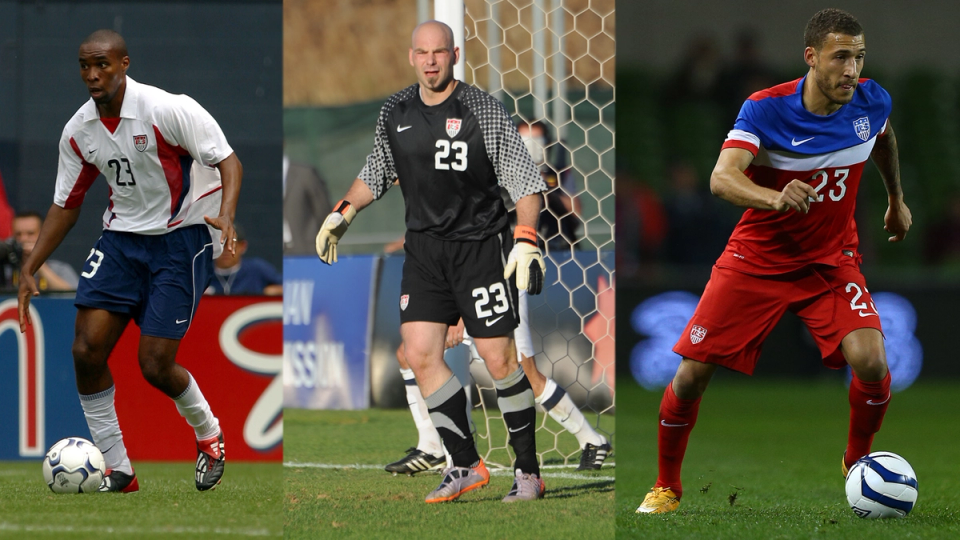
Pope returned for his third FIFA World Cup at Germany 2006, starting two of the three matches. After the disappointing 3-0 defeat to Czech Republic, Pope was the second U.S. player sent off against Italy, receiving his second caution in the 47th minute. Suspended for the group finale against Ghana, he joined Brian McBride and Claudio Reyna in announcing his international retirement a day after the USA’s exit from the tournament.
After wearing the No. 19 as the third-choice goalkeeper in South Africa, Marcus Hahnemann got the No. 23 in the same role in South Africa. Fabian Johnson was one of the USA’s top individual performers four years later. The German-born midfielder was asked by U.S. boss Jurgen Klinsmann to slot in at right back, playing all four matches during the USA’s run in Brazil.
2002: Eddie Pope – 5 GP / 440 MINS
2006: Eddie Pope – 2 GP / 137 MINS
2010: Marcus Hahnemann - DNP
2014: Fabian Johnson – 4 GP / 302 MINS
With rosters expanding to 26 players in 2022, Josh Sargent (No. 24), Sean Johnson (No. 25) and Joe Scally (No. 26) will become the first U.S. players to wear their numbers at the World Cup in Qatar.
Sargent continues with the number he wears at Norwich City, while Johnson will stay the wear number he had for six seasons with the Chicago Fire at the start of his professional career.



